My time in Hong Kong was very condensed this year. My apologies to the friends I could not meet this time. Thanks also to the great students from the MBA programme of Hong Kong University and the GBA stream coming in from Shenzhen to participate in a 5-day intensive course on Turn Around Management and Corporate Restructuring …
China's 14th Five Year Plan
China's plans have always been ambitious, especially in terms of growth rates. But of course, as the world's second-largest economy, quality aspects have been on the rise already long before the latest "Two Sessions" of the People's congress. China's economy is in transition, and it is clearly becoming harder to improve "one dimensional". While in recent history, plainly "horsepower" of the economy also reflected in the general improvement of quality of life and poverty reduction, now efficiency and resilience come more into play. Revealing the draft of the 14th Five Year Plan, it also becomes clear that China will deal with long-term structural issues, starting from overaged demography, socially unsettling topics to further economic reforms and strengthening of domestic innovation. The numeric targets of what has to be achieved by 2026 have become far less assertive than in the previous year, except those which directly measure the quality of life and successes in e.g. the reduction of Carbon-dioxide emissions. A compilation of some of these targets by Merics you find by clicking here.
The year of pandemic, following four years of a trade conflict with the USA and uncertainty about the new US administration, continuing a "tough stand" has left its traces. The American rhetoric is less vulgar but still appears to follow similar principles than the previous administration. Meanwhile, China continues to attract FDI and continues opening up sectors for foreign investment. Economic recovery started earlier in China than in many Western countries, giving some headspace for tackling unemployment, strengthening the middle class, domestic consumption and laying the foundation for becoming more independent in key components and technologies.
Externally, the RCEP Free trade agreement is now combining markets of 3.6 billion people, and some of its member countries, which pick up production of low-cost, labour-intensive industries from China, can now export their goods duty-free to China. Beyond this, China stays committed to partnering with and investing in countries along the One Belt, One Road Initiative. For the relation to Europe, the recently signed China-EU Investment agreement forms a platform on which further co-operation will be achieved. The likely effects of this agreement will also fall into the period of the 14th Five Year Plan.
With reaching the threshold of transitioning away from an emerging economy, China takes another role in the international community. This reflects a stronger economic and cultural presence abroad and is seen in joint efforts tackling global challenges and threats.
Whatever specific measures will be taken to roll out the 14th Five Year plan, we will see changes that go far beyond the "reform" of previous plans in terms of quality before quantity.
The New Silkroad: Opportunities
We are forming a multinational network of experienced researchers and executives on policies, practicalities and opportunities related to the One Belt, One Road Initiative; sometimes also called “The New Silkroad”. Soon there will be a website launched at www.silkroadexplained.com providing information and commentary on the status quo and developments.
When thinking about business opportunities in the New Silkroad context, what comes to mind first are extensive infrastructure and energy projects. Railways, ports, highways, pipelines and power plants, including their financing services, have been in focus in the first stage and still are. But these operations serve a purpose, which is to create economic opportunities along the way. For centuries, where trade routes crossed, wealth immerged, cities flourished, living standards rose, and migration drove goods and services' demands.
Different countries, participate and benefit differently from the Silkroad. There are those which are getting alternative logistic connections with their traditional trading partners, like Europe's railway connection to China. In the volatility of geopolitical conditions, these can even become a vital lifeline. Other countries benefit from the FDI influx and later use the infrastructure to access new markets, potentially upgrading industries from raw materials, over manufacturing to higher-margin goods and services. Also, transit countries can participate in upgrading handling capabilities, once the infrastructure is in place. Lastly becomes visible, even the direct cost of low efficiency, instability and corruption. Participation in trade need reliable partners, and volatility becomes a missed opportunity.
Infrastructure opportunities
Infrastructure investments are the main foundation and pillar of the Silkroad. There are myths around infrastructure projects would "all go to Chinese State-owned Companies." Chinese companies have capabilities and technology to operate in environments with thin infrastructure. These reach from building railroad tracks in permafrost to telecom and digital infrastructure. But this does not mean that a large proportion of projects outside China are not projects awarded to Chinese companies. With the need for stronger multinational leveraging of financing, there is no interest in over-dominating Silkroad projects with Chinese contractors.
Financing opportunities
The AIIB is an example of a multinational bank, based in Beijing, dedicated to investing in Asian infrastructure. But with the need for international leverage, financial institutions and governments from around the world participate in the financing of Silkroad projects. This is also where many of the most capable practitioners are found.
Increase and movement of purchasing power
Increased purchasing power and migration are the foundation for the demand for goods and services in a region. Rising professional opportunities and standard are like a magnet and in some areas have proved to be able to revert trends of people moving to large cities. This creates opportunities reaching from retail to supporting functions.
Where whole cities are built up and redesigned, the spectrum of opportunities reaches from urban planning to architecture projects to development and construction.
Qualification and training opportunities
Building up an operation in a new region to be developed and upgraded always poses challenges in finding qualified human resources. Qualification, training and education are the key dimensions on how to overcome the short supply of workers. It includes cultural integration and exchange as a foundation of bilateral cooperation.
Health and Sustainability
The Health Silkroad and the Green Silkroad are the newest additions to the programme. They follow the bare necessity of providing better healthcare services in emerging markets and the apparent learning that much damage and cost can be avoided by choosing and implementing more sustainable economic developments models.
What does the EU-China Comprehensive Agreement on Investment mean?
In December 2020, as part of its evolving partnership, the EU and China formulated an agreement on the investment conditions. By catering to both sides' changing interests and demands, it lays a foundation for a boost in economic activity and an interlinkage between these large markets. It remains to be seen whether it really brings about a "level playing field" for EU and Chinese investors, during the process of detailing and ratification by the EU parliament and the member countries. But it will surely be a less "inclined plane" and will therefore have enormous potential for an economic boost.
Background
Since the opening of the Chinese economy in 1979, the welcoming of FDI has been a characteristic of the Chinese economic development model. Even so, the full and independent market participation of investors was constrained by regulation. Given the low competitiveness of many state-owned and privatised companies, such restrictions aimed at building up a strong domestic industry, without facing unfettered competition from foreign entrants. This resulted in many "technology for market access deals" and the obligation for foreigners to form Joint Ventures, as for example, the automotive industry and other core pillars of China's industrial development. With China joining the WTO in 2002, the full repatriation of dividends to foreign mother companies became possible. Prior to this, overpayment by Chinese Joint venture partners for goods, services and IP was a common way by foreigners to take money above the line, out of China, with all the implications of the loss of corporate tax incomes for China.
Since then, Chinese companies have improved significantly in competitiveness, technical capabilities and market access. As a consequence, foreign investors have become more vocal in describing the regulations as unfair. Some even realised that their Joint Venture Partners have grown to become fully fletched competitors on the global stage.
From a Chinese perspective, it also became clear that "overprotection" of domestic companies, was not helping them develop their own capabilities, but weakened them and kept them dependent on foreign joined venture partners. It became a Chinese interest to find the right level of protection to encourage healthy competition. Simultaneously, the boom in Chinese Outbound Direct Investment (ODI) raised the interest of Chinese companies in creating a level playing field.
What are the interests of both sides?
Chinese authorities know about the value of healthy competition in developing a strong industry. For over a decade, they have been withdrawing regulations in order to balance power between foreign and domestic companies. On the other hand, in Europe, there are voices for more substantial restrictions designed to limit inward Chinese investment. For example, A landslide case in Germany was the acquisition of the robotics company KUKA by the Chinese Midea, which led to significant changes being made in the German company law. The question of a level playing field is not about Chinese making concessions, but it is rather a discussion between equal partners with similar interests.
Most of the EU investments in China fall into manufacturing, 28% for the automotive sector alone and a further 22% for materials. Among others, this includes the production of cars, chemicals, telecoms equipment, and health and medical equipment.
China's investments in the EU investments include IT and financial services, healthcare, environmental services, international maritime transport and air transport-related services. Due to the concerns of inefficient capital outflows out of China, in 2016, one of the licencing criteria for ODI became a demonstration that the investment should fall under the scope of the "One Belt, One Road Initiative" (BRI or OBOR)
What are the new commitments from both sides?
European companies will gain from more consistency for their operations as China reduces entry barriers, and access restrictions and discriminatory practices, or even eliminates them altogether. will
Chinese State-Owned Enterprises, especially, will be required to provide "transparency of subsidies, prohibiting forced technology transfers and other distortive practices."
While China guarantees easier authorisations for European companies and complete administrative procedures, the EU provides access to Chinese companies establishing European bodies for their entities.
China no longer be able to attract investment by lower environmental and labour standards, so it committed to implementing the Paris Agreement on Climate Change and will make efforts to ratify the International Labour Conventions on forced labour.
Analysis
The EU - China Comprehensive Agreement on Investment is an ambitious milestone in developing the Union and China's economic ties and partnerships. It is set to be modernised according to changing requirements.
Clearly, for China and the EU the deal, negotiated under the German EU presidency, is a significant success. However, national ratification by the member states and obtaining the consent of the EU parliament may be more complex. There could emerge an attempt to increase pressure on China in terms of potential human rights issues.
It remains to be seen, how the US-Chinese relationship develops under the new US-Administration. The newly sworn-in US-Defense secretary has already called on Asian allies to strengthen military ties. The EU will become a subject in the triangulation of geopolitical power.
For both, EU and Chinese companies, the current agreement significantly reduces access barriers and restrictions, so that volume and quality of transactions, trade and conditions will improve to a new era.
After a chaotic week in Hong Kong
The tensions have been building up, at least since I had moved to Hong Kong in 2006: dangerously unequal income distribution, monopolistic real estate development, and fading prospects for the young. I left Hong Kong and moved to Bejing in 2011.
After a century of British occupation, China left Hong Kong untouched and in the spirit of an experiment, whether an ultra-capitalist system can deliver superior living conditions and what can be learned from this. It has been evident for years that this experiment has failed. The British had set up a system of mistrust to the Hong Kong Chinese, and a tight mechanism of checks. But they did not build up a Hong Kong Chinese elite, which would be able to step into their role and at least lead somewhere. Like all their colonies, Britain has ruled these places for the benefit of Britain, not the local people. The tale that Britain brought infrastructure and education to colonies is often distorting the fact that this was only to exploit the colonies more efficiently and to have qualified servants. This is how Hong Kong, for example, became a city of accountants and completely failed to build up technical knowledge or the capability to innovate. Until today, large parts of the education system are mere training entities for useful skills. Very rarely, you find an educated person, and if so, they often come from the Chinese Mainland. One of the last British stunts before the handover was to make the British electric power socket compulsory, to fill their own order books, and make things incompatible to China. Divide and conquer down to a micro-level. I am sure the last British Governor, Chris Patten, has more romantic things to say. That's something they do well: talking.
Four months ago, the bubble burst (a second time). Millions demonstrated peacefully against the implementation of an extradition agreement between the Hong Kong SAR and its mother country. Hong Kong has extradition agreements with many countries. And given that one of the key "services" Hong Kong has to offer, is money laundry and facilitating asset transfers, you can imagine that China does not appreciate having a save heaven for economic criminals within its own borders. But sure, you can't ignore the fears of millions, so the extradition bill was withdrawn. But the frustration, of course, stayed because the extradition bill had nothing to do at all with the shortcomings of Hong Kong's governance. I guess it could have been anything sparking unrest.
Since then, the peaceful protests have bred a violent group going on rampages destroying public and private property and using iron rods, slings, brick, Molotov cocktails (petrol bombs), and sharp objects against citizens and the police. For what I have seen, the police are handling the situation very defensive. Just the fact that there have been until today no casualties is terrific. I cannot believe in any other country, at this level of violence, you would have nobody killed yet.
I have talked to University students ganging up for rampages. They don't know a lot of facts and have a very naive belief in what they think "democracy" can do. Riots give them a sense of belonging and "purpose" in their, at other times, boring and quite meaningless lives. Luckily most of them learned their infantry skills from catching Pokemon and other video games. I do believe they live in some augmented reality. But that they have no clue what they are doing, does not mean they can't be physically dangerous. If you have ever seen what happens in a chicken stable when they start hacking down on a chicken that struggles: this is how these kids fight. They smash from the back people who are struggling, and then they run. Not exactly Bruce Lee. At the same time, they talk of "police violence" and even demand an independent investigation. My guess is that this investigation would find that the rioters have been treated very mildly. Too mild for my taste. But that's perhaps a different cultural viewpoint.
The infrastructure is undergoing repairs, while the rioters now focus their violence on Mainland Chinese shops and tycoon's property. I had to tell a bunch of them off today who wanted to make trouble to the staff in a Park & Shop convenience store (owned by Li Ka Shing, who definetly is a contributor to the struggles of Hong Kong people). They would really harass some of the poorest of the poor Hong Kong shop workers, laboring in this store "to teach Li Ka Shing a lesson". What a bad joke! I can't help thinking of the Nazi mob in Germany in 1933 looting and burning Jewish stores. This was the beginning of a very dark chapter in world history. I hope here things clear up and start to tackle the real issues. In the end, most of Hong Kong's problems are homemade. And if China would not protect and support Hong Kong SAR, most of the accountants here would be already back to fishing.
Star ferry to Kowloon. The good news is that it’s not crowded.
I understand, it’s hard to “think outside the box”, if you live like that (opposite Belcher’s Towers, Pokfulam)
Stanley Tin Hau Temple
Average 78
In the last weeks, during the APEC conference, we were spoiled with blue skies. But today Beijing put on its grey face again, as if it wanted to remind me, that it is really time to go. Something changed though, since APEC is over. The website of the American Embassy air quality monitor is censored now by Government Order. And the published reading for the city average shows AQI 78, which is now called “good”. Somehow I can’t match the view out of the window with the data. I must be just in an exceptionally bad area, if the city average is still 78. Happy for you guys out there in the rest of Beijing. And sorry for dragging down the city average.
Future Antiques
My wardrobe and bed made a long way. Custom made in Hong Kong in Chinese Style, then shipped to Lamma Island, dragged by hand on a cart over the car-free tropical island. Later let down from the balcony on a rope to the garden, shipped first to Hong Kong Island and then trucked up to Beijing over about 2500 kilometers. And even more than that they have been part of my home, where ever they were. It is time to leave them behind in China, as that’s where they belong. I am very happy that they will go to a 200 year old Courtyard Hutong, which is owned and renovated by the grandson of a teacher of Deng Xiaoping, who went to France in the 1920s. As they always had contacts to foreigners, in the Cultural Revolution, they were accused of being spies and him and five other colleagues were murdered by his students. Now, Mr. Zhang, who is the grandson, is bringing the courtyard back to the spirit of his grandfather and host international travelers, who do not travel as “tourists”, but as guests. Once I was asked, why I don’t buy antiques. And my answer was, that I prefer to make things which are so good that they will become antiques. Perhaps, that’s what happened.
"The World's Worst Paradise"
I wanted to post a small photo gallery of some of our Saturday walks in Beijing. But since APEC is over, not just the smog came back, but also the Internet is more crippled than before. There has been a lot of cynical talk about Beijing being able to clean up its mess for the international conference, but not for its own people. But I think this was a very interesting experiment, determining how much industrial production, traffic reduction and economic activity actually has to be shut down or switched to something else to make Beijing healthy again. At least we have a data point now. Getting 50 % of cars of the road, is one of them. Closing more than 2000 factories is another one. Good to get a feeling for the magnitude. This needs more than just a few filters in chimneys and another subway line. It means a whole structural change, not just of Beijing, but also in the wider surroundings. And another datapoint we have, is to see how nice Beijing could be. When I had lunch with a friend last week, he named Beijing “The World’s Worst Paradise”. Compared with other cities, I agree.
As of Internet, a few days ago my VPN account expired and won’t expand its service only for a few days more until I leave. The the upgrade of my MacBook’s operating system seems not to be very helpful either. So, I don’t exactly know what cases the problem. Luckily, my website can receive mailed in posts, which do not require me to log on the system itself. That makes it easy to publish, as long as I can send e-mail. But the features are a bit limited. So, I don’t know what you see, until I have a chance to open my website myself again.
All I attach for now, is a photo of the small bridge in my favorite Beijing Park, The Temple of The Earth. More will follow, after we crossed the Great Chinese Internet Wall. I have seen this bridge many times and in different seasons, also with lush grass and bright flowers around. This time it is having the atmosphere of cut flowers after you had them for a week. Don’t want to let them go, but happily looking forward to go to the flower market again and get some new ones. That’s the mood I am in looking at the whole city these days. Time to leave in a few days from now.
Ente gut, alles gut
Beijing made us really a wonderful farewell gift, as we are strolling through it this weekend under APEC conditions. As the impression often is shaped by how the whole experience ends, this looks like a perfect epilogue to our time in Beijing. Today we drove along the Changan Avenue, passing by Tiananmen Square to visit friends on the other side of the city. The sky was blue and the traffic in flow. The traffic management simply took half the cars off the road and put at least one traffic police every few hundred meters. The Tiananmen Square itself is heavily guarded by military and armed police. While we were driving along the landmarks of our memories of Beijing, we nearly felt like a "state guest" ourselves, even we were not in one of the black limousines, but just on the back seat of a shabby Hyundai taxi. Even the air is really clean in some areas you are advised not to open the window, as there are snipers on the roofs, which might misinterpret that move. Well, there is nothing I want less on my last days here than a nervous sniper. You can't have it all. But that's fine for me. As we say here: Ente gut, alles gut.
North-East of Inner Mongolia
When I was a child, anything coming close to Vladivostok, was at the end of the world. Today, I know that the main difference between the far Northern East and the extreme American North, Alaska, is the narration I received. Alaska was told to me by people like Jack London. They were stories of gold rush and adventure. The stories of the far Northern East, were told by my grandfather. They told about displacement, gulag, starvation and insane dictators (responding to our own insane dictator). Last week we flew into Hailar and made it to Shiwei, then up the Chinese-Russian border close to the most Northern Chinese tip. It is a region, which was been signed over by Heilongjiang to Inner Mongolia. It is the end of summer. And it is beautiful.
Inner Mongolian Grassland, North of Hailar (People's Republic of China).
Inner Mongolia is for me the synonym of endless grasslands, but heading North these very soon change into a birch forest vegetation and then into the Greater Khingan Forest. The border to Russia is perhaps the best protection of the Yalu River, as it is fenced by barbed wire and marks the National Border just in the middle of the stream. There is trade of building material, wood and stones between the countries, but not much of an interaction, except the exchange of money against goods part. The few towns are like Jack London's gold digger towns. Just, that there is no gold.
Shiwei centre - A Chinese border city to Russia
Heading for a peak, to get a good view over the forest, suddenly Jack London came much closer than expected. We walked up a steep slope, with bushes to our right. Feibai was sick of the height and was wondering how to get down again. I was wondering what was following us in the cover of the dense forest and saw with suspicion grass pressed down by some really big creatures lingering there. Kind of naively, I asked: "Any wolves reported here?"
Forest view in the most Northern region of China.
It did not take much longer, until I saw who was looking over the hill ahead, ready to block our way: at least two bears. Shit! I have never seen bears in wilderness, and they were obviously more than our size. I wanted to turn back over the rocks, staying at distance of any bush providing them cover. But I was also aware that they would not really need to hide from us two little creatures. I requested Feibai, please to walk like a healthy animal in the eyes of a bear, and I was not sure whether she got the message what that means. At least she was not afraid of the height any more. We still had to cross a dense forest band, back to the "road" and were completely venerable to meeting the bears. There are no firearms allowed in China, so there is no, what so ever, chance to survive the attack of bears. But they did not attack. Don't know, whether is was our "supreme tactics", moving in the forest, or whether we were just really, really lucky.
There is another thing about Mongolia, which I nearly forgot: the Mongolians. They make only about 10% of the local population in Inner Mongolia, and have their own language and writing. They are nice. But actually, everybody up here is nice, no matter which ethnic. When winter drops down to -50 Degrees Celsius and summer is short, you better treat your fellows well.
The far North-East is a "no bullshit country". And there are not many left of it. They had no Jack London, but I think they deserve one. Even there is no gold. There was also not much in Alaska, lets face it.
Mongolian grasslands and swamps.
Beijing on a clear weekend
These are windy days and it is nice to see the blue sky and even some stars in Beijing. Also the traffic was not too bad this weekend. Well, I spend most of the time away from the busy crowds anyways and enjoy my last few months here, to keep the city in a good memory. A weekend like this one, make it easy.
View from home at a clear full moon night.
Early Sunday morning in the Temple of the Sun Park.
Lotus flower, as seen in Temple of the Sun Park.
Hyperopia
Finally my arms got too short to properly be able to read small text. They call it Hyperopia, and it means I am getting far sighted. First I though of getting longer arms is not that easy, and may look rather imbalanced when I am scratching my feet walking along. So we went to the Beijing Glasses City. Here you get custom mades glasses starting from 5 Euro, and it is quite some fun also.
A wide range of entry models at the Beijing glasses city.
Hans van Dijk - 5000 Names
I found 5000 Names is a very interesting exhibition on the Chinese work and legacy of the Dutch born curator and scholar Hans van Dijk. It shows works, letters and artifacts of the time in the 1990, when he was a mentor of the coming generation of contemporary artists, when there was no such thing in China.
The exhibition is running until August 10th in the UCCA Ullens Center of Contemporary Art in the 798 Art District, Beijing.
Exhibition entry and introduction.
Builders at the Sheshan Observatory
Sorting photos in preparation for exhibitions, I came across these two snapshots. One is taken 2004 and shows workers doing maintenance work at the Sheshan Observatory. When they saw me climbing around the roof with a camera, they posed for a photo, as if they knew (they didn't) there is a similar photo dated 1899 which is hanging in the Observatory Museum, literally below their feet.
Builders at the Sheshan Observatory, as seen in 2004.
A picture of builders of the Sheshan Observatory from 1899, as seen in the Observatory museum in 2004.
Baojin Shankou Hike
In the South-West of Beijing lies a limestone area resulting in a magnificent karst landscape, North and South of the Baojin Shankou Canyon. There was a bit of haze today, but it clear weather it must be even more beautiful. On the South there are gardens and small farms. In the past all over here food was grown. Now there are just remains left, but they are still active.

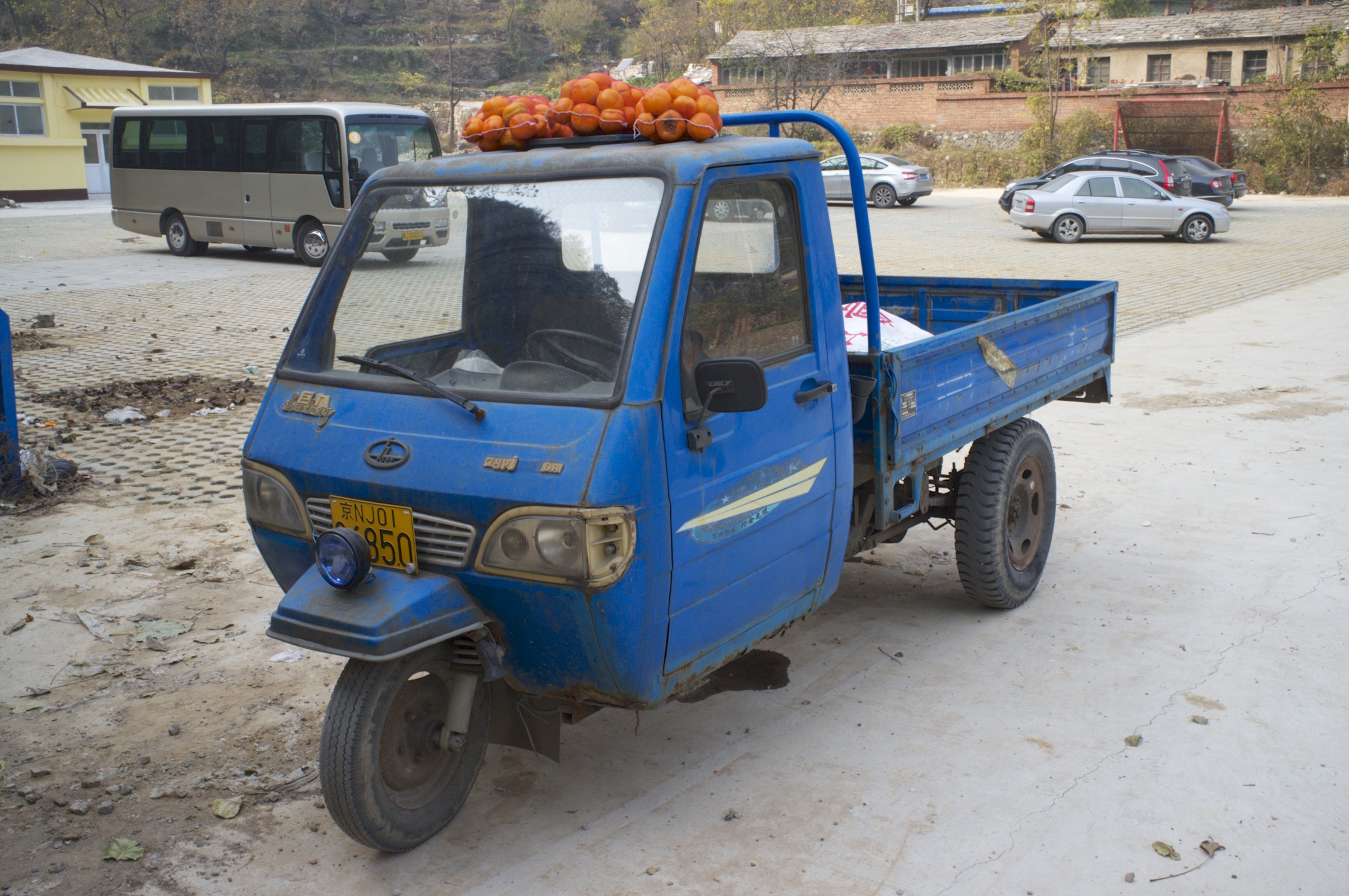

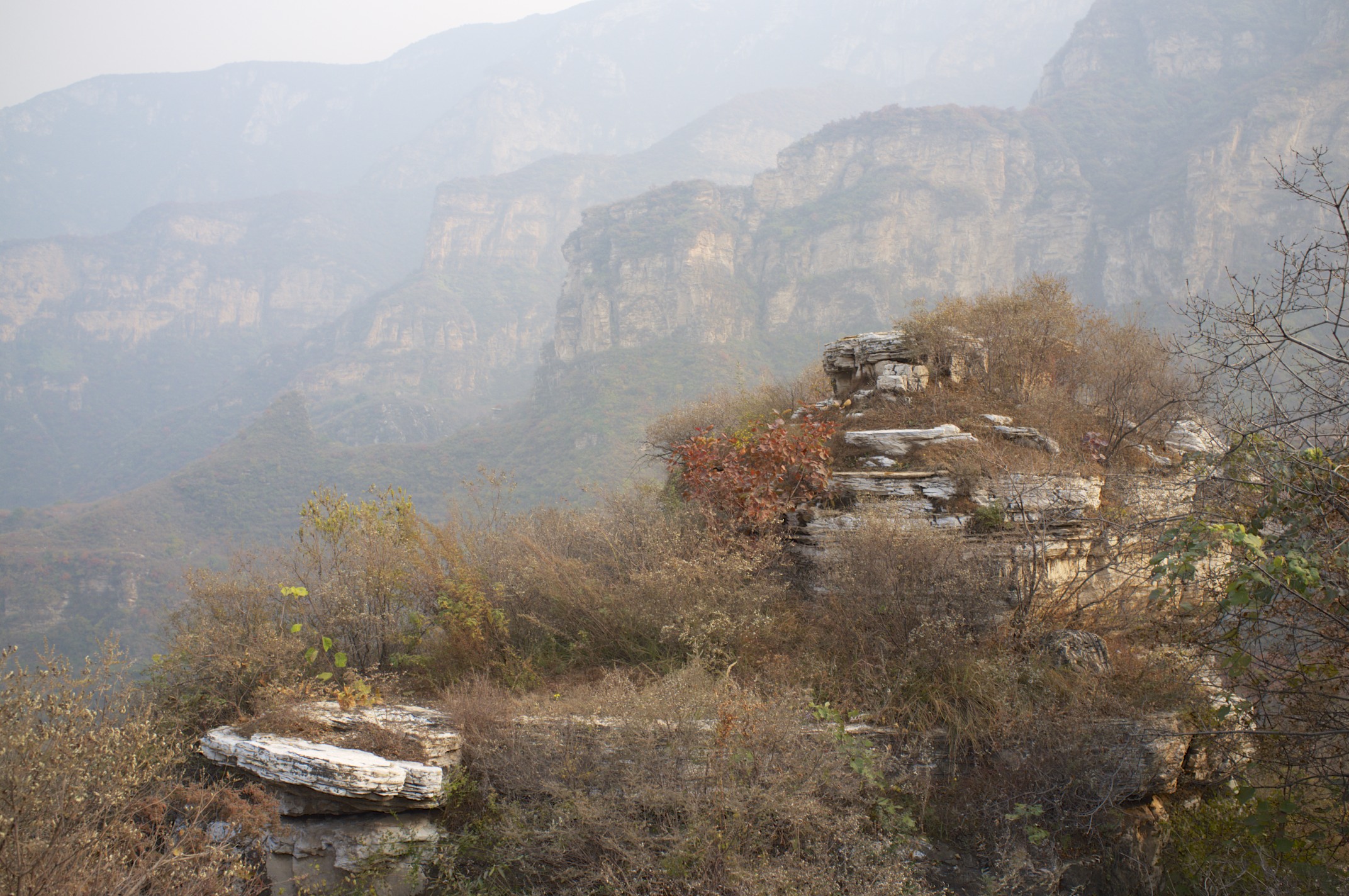
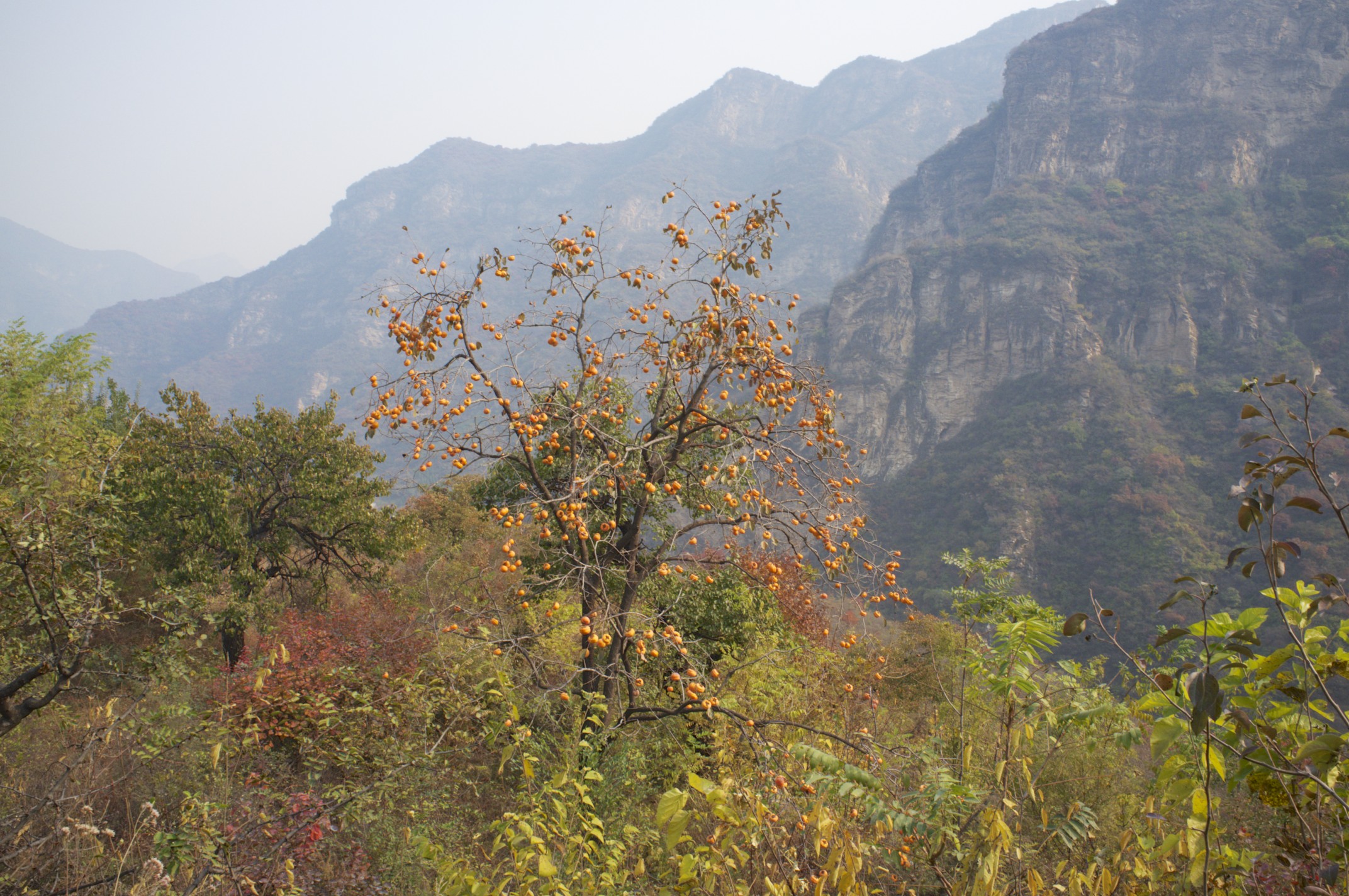
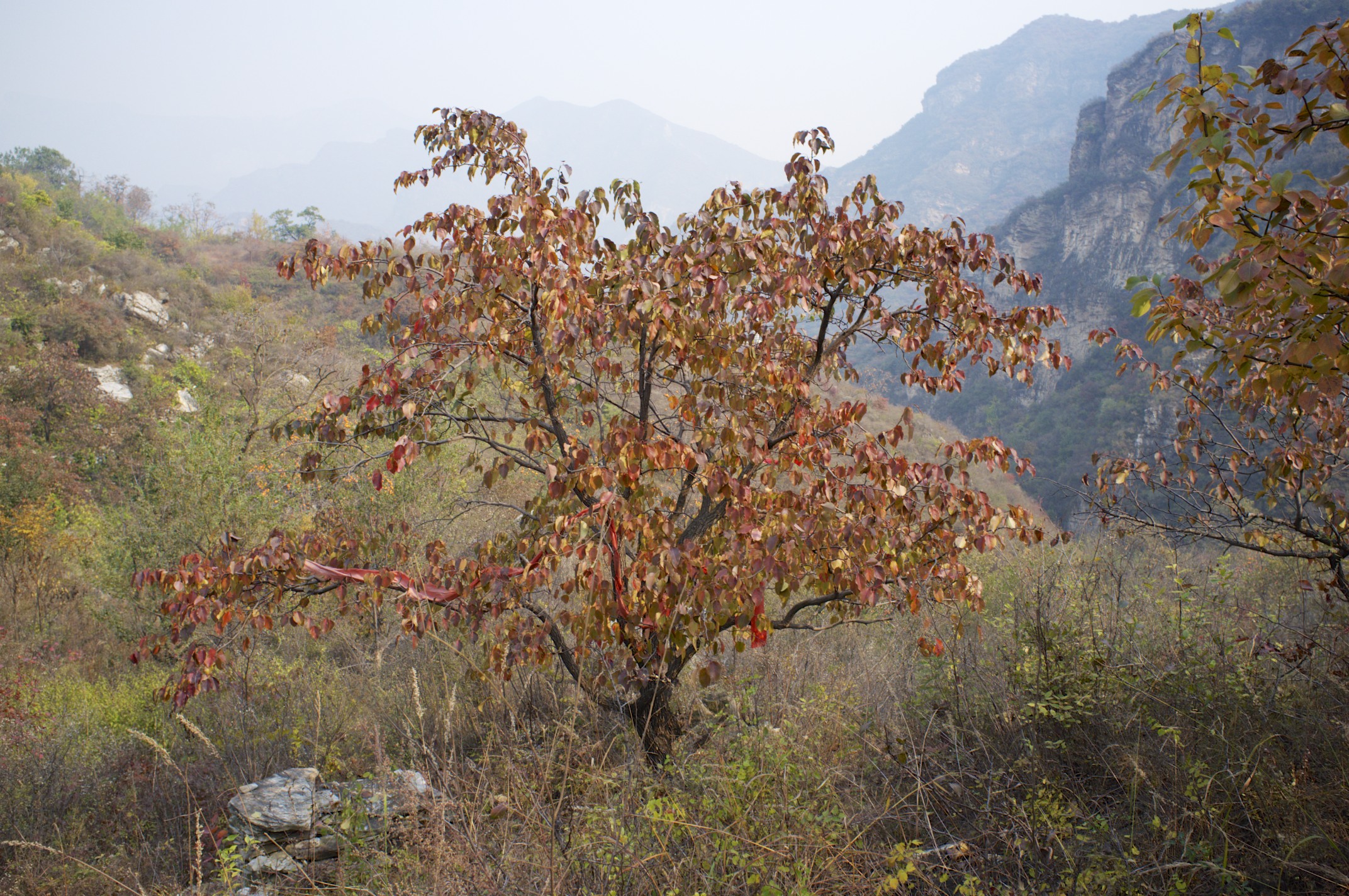
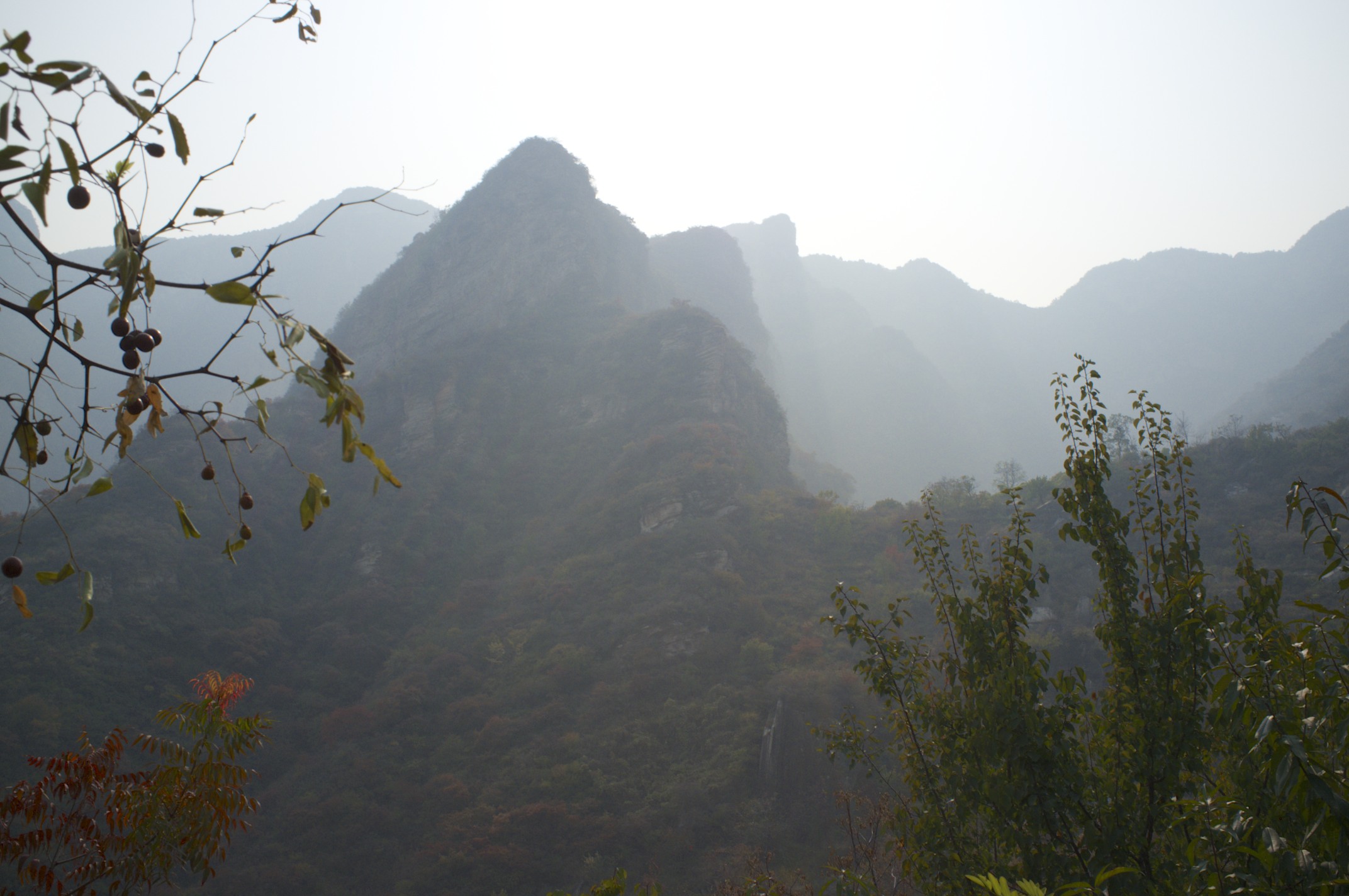
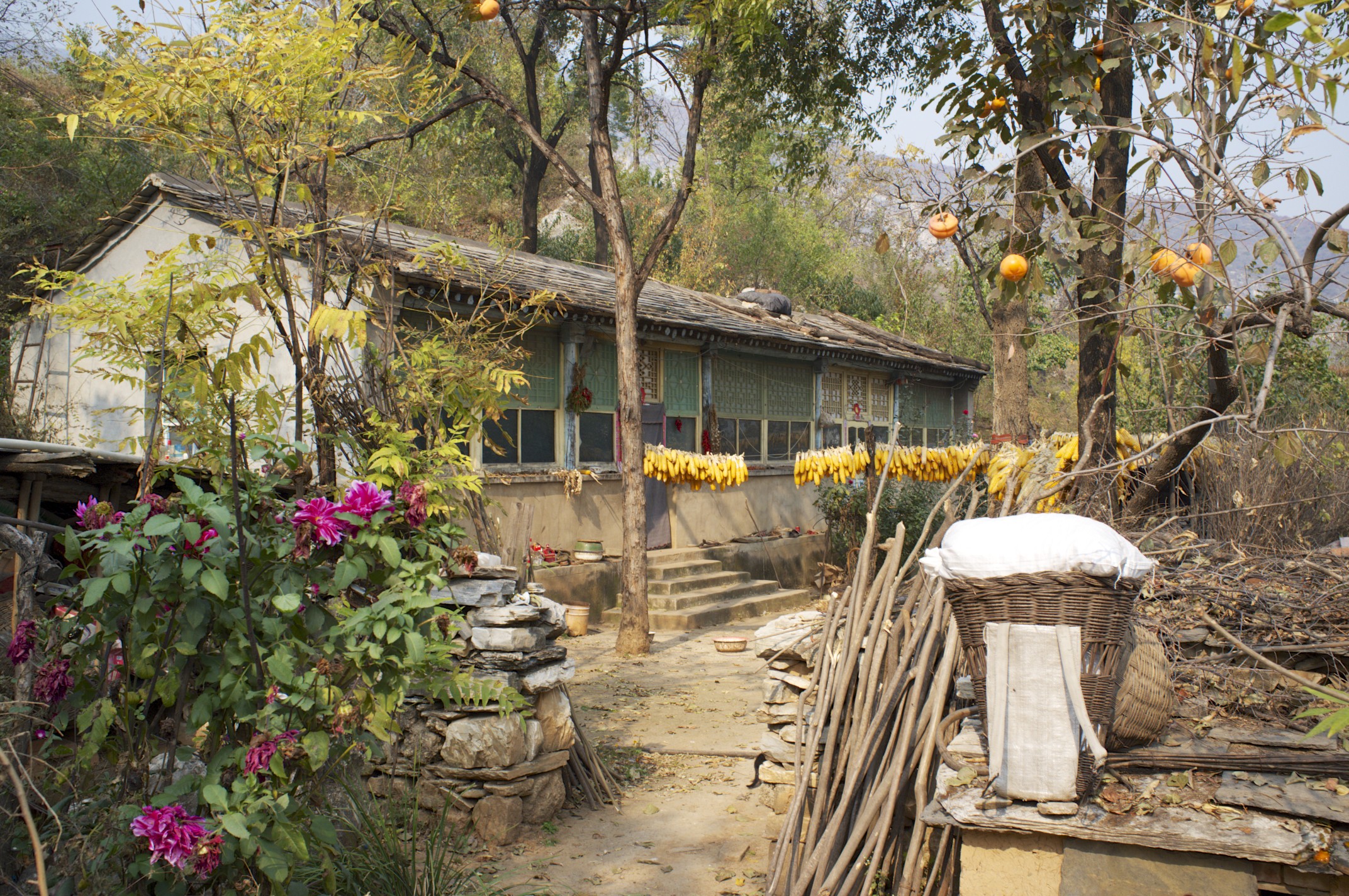
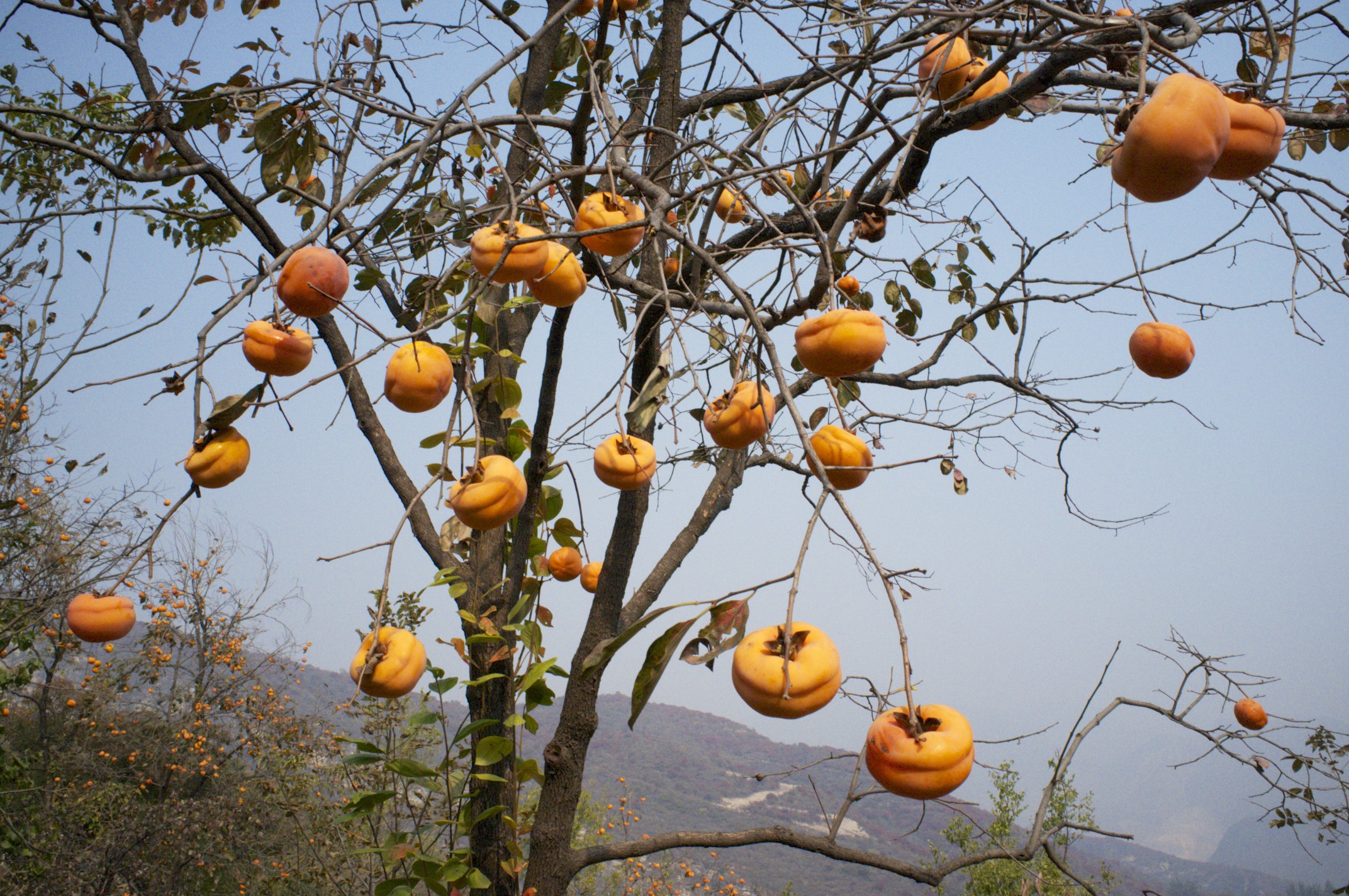
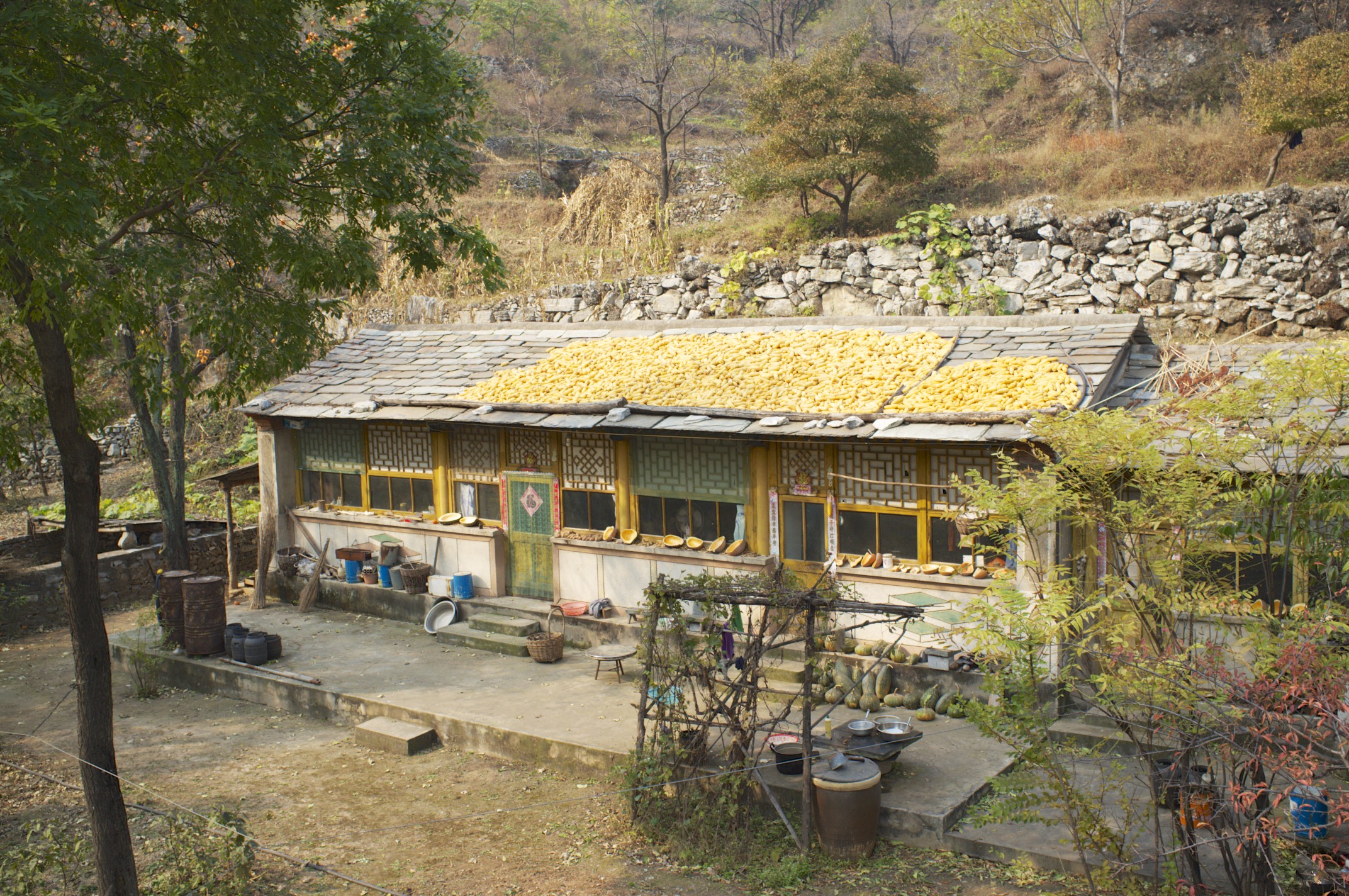
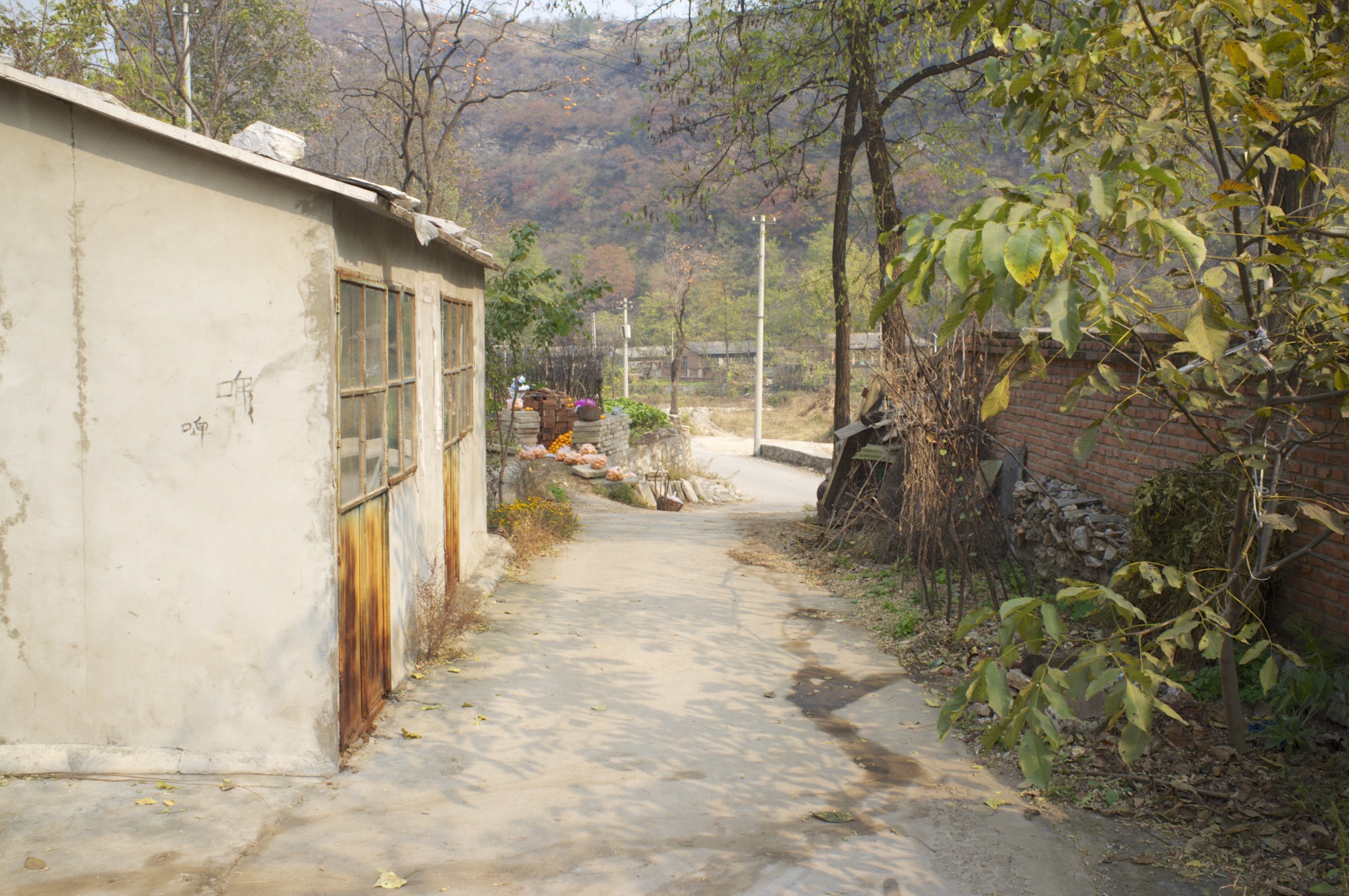
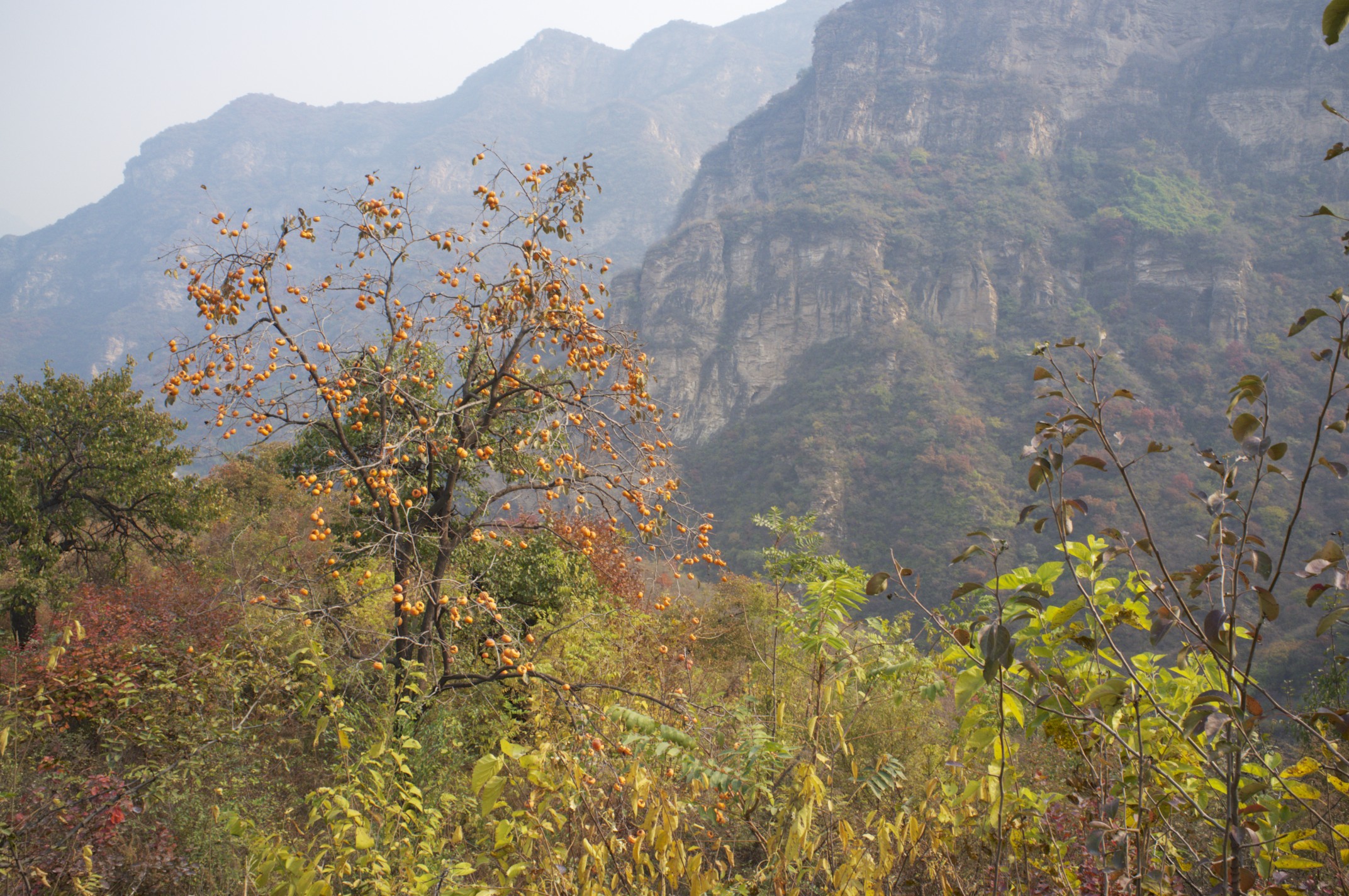
You may download here the GPS track in gpx- and tcx-format. We started a bit late today and did not explore the area to the fullest. Given the geology, there must be caves around. We met a teenager with a torch (and an acrobatic throwing knife, which impressed me a lot) who was heading for one of them. But we returned to avoid sunset before reaching clear trails again. To reach the starting point you will have to cross a bit of "Tourism with Chinese characteristics". But no worries, they will all disappear into some sort of park worshipping with their mobile phone cameras some sort of plastic Confucius. This absorbs them all, really.
Here comes position and GPS plot:
Development knocking at the door
Before traveling to Europe for about a fortnight, I cycled along some old residential places in Beijing. Actually, they are not old by normal standards. But they have become rare here, while land has become incredible expensive. They are not in good condition either, and would be costly to renovate; not even to think of the "opportunity cost" versus putting a few high rise buildings there. They are not Beijing Hutongs, which have been partly accepted to be a heritage, and they are neither "useful". So, they are neither seen as heritage, nor are they viewed as something of value. Their time has come.
I decided to come back with a camera and take a few snapshots. I was lucky, because when I returned today, some of them were already demolished (the satellite photo underneath still shows the blue roofs which show that this was a more recent development) . They are/were along the canal, outbound the city, beyond the 4th ring. Please refer to the co-ordinates in the grid below for exact location.
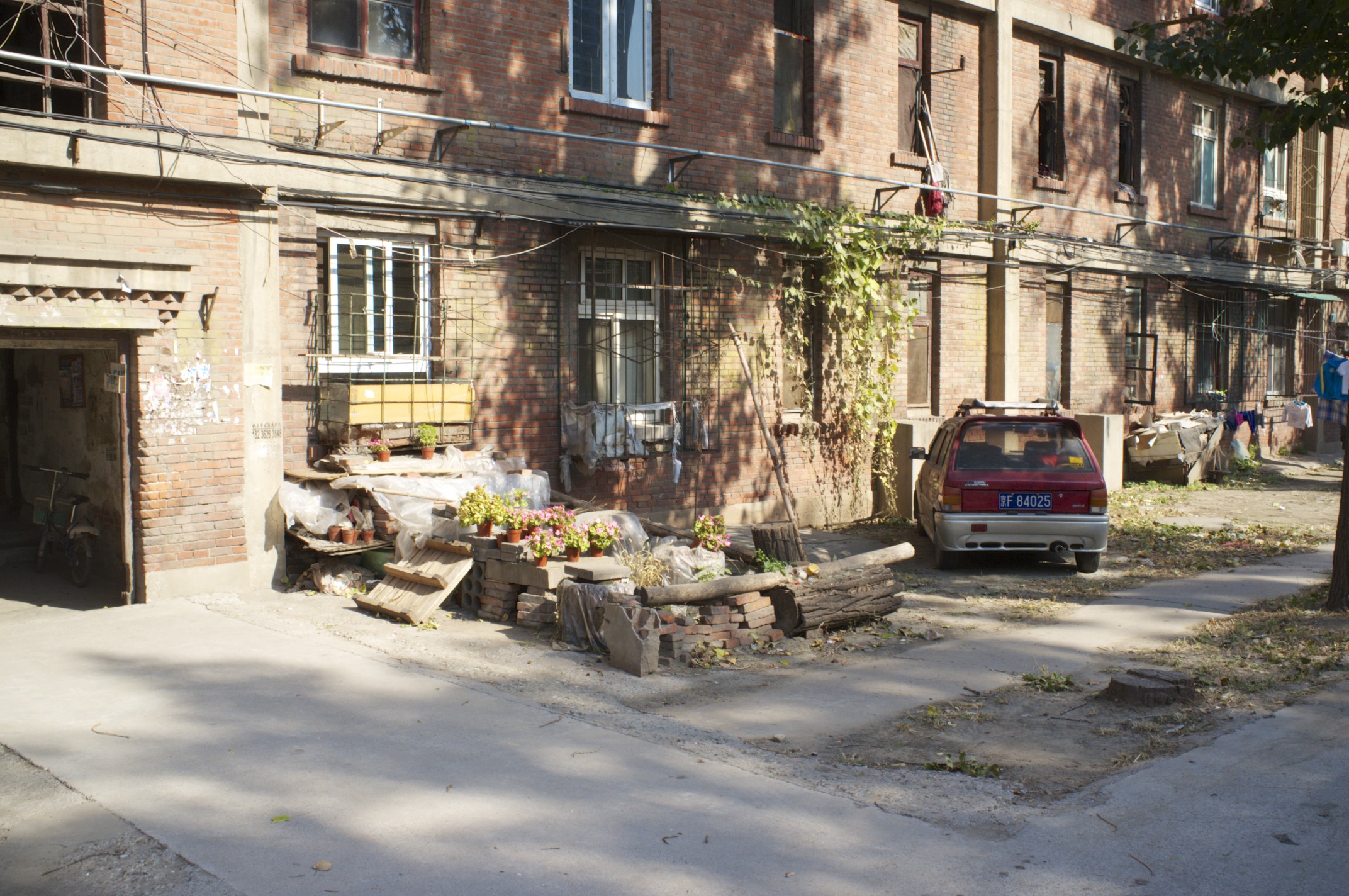

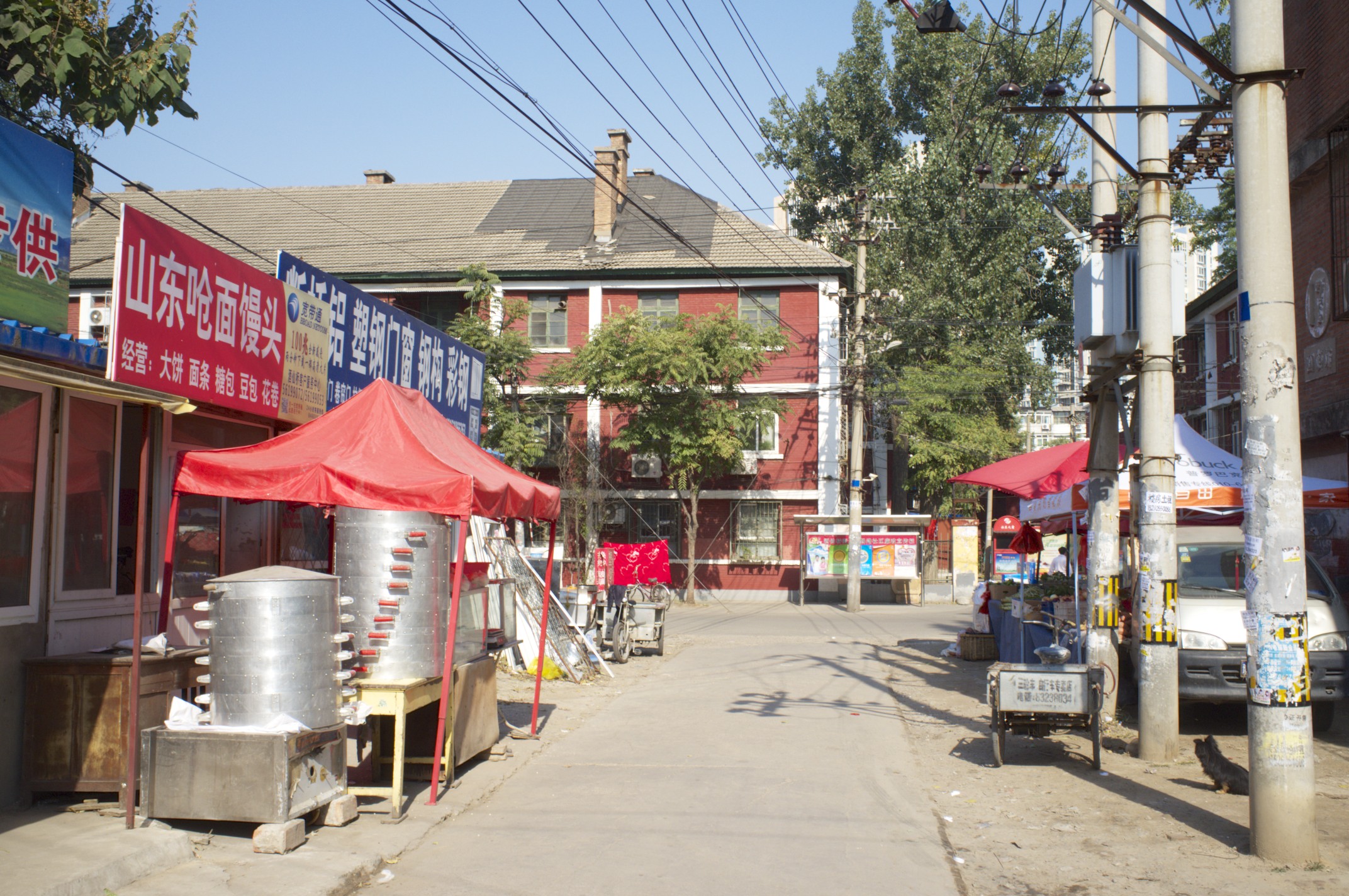
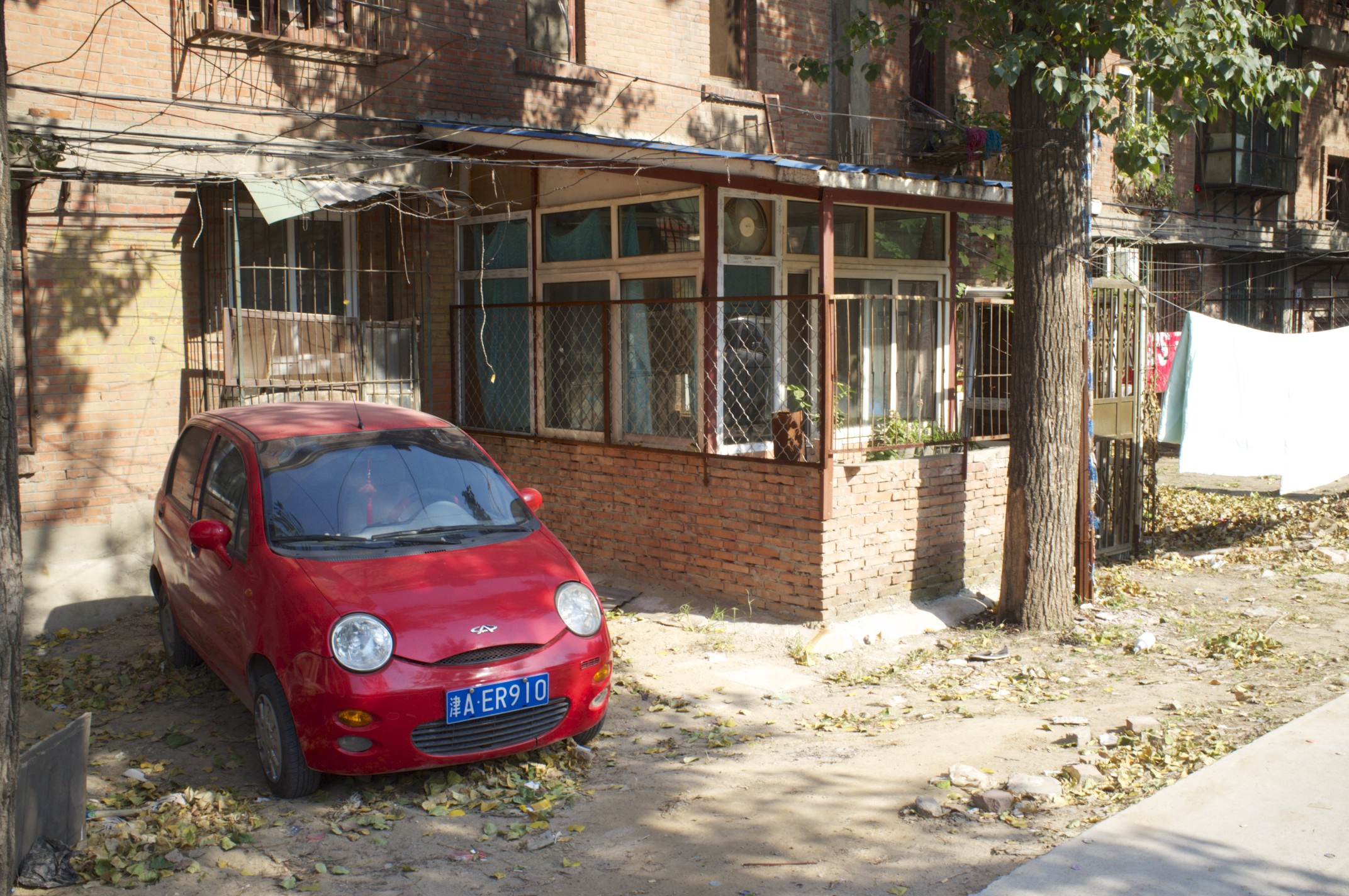
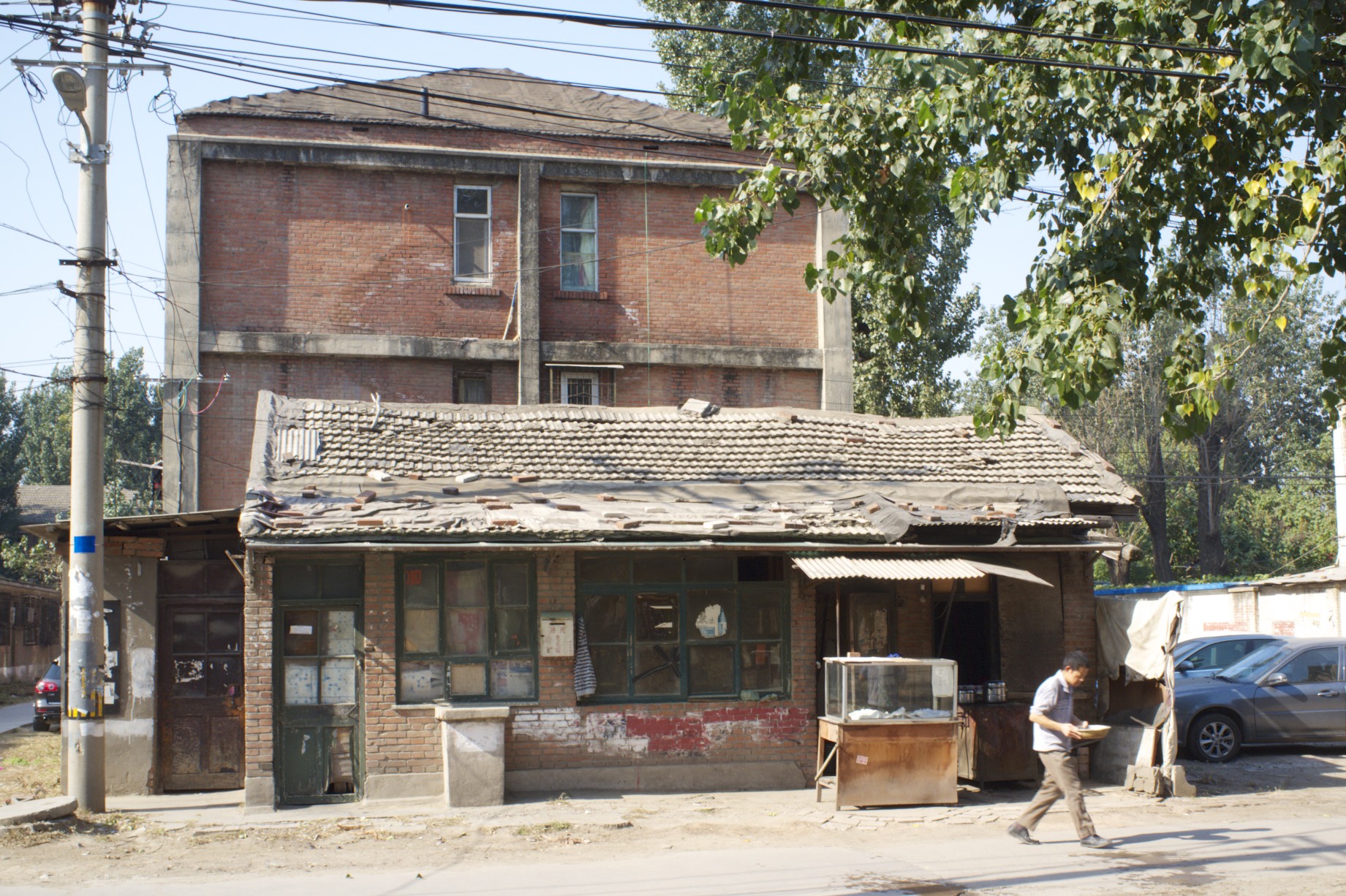
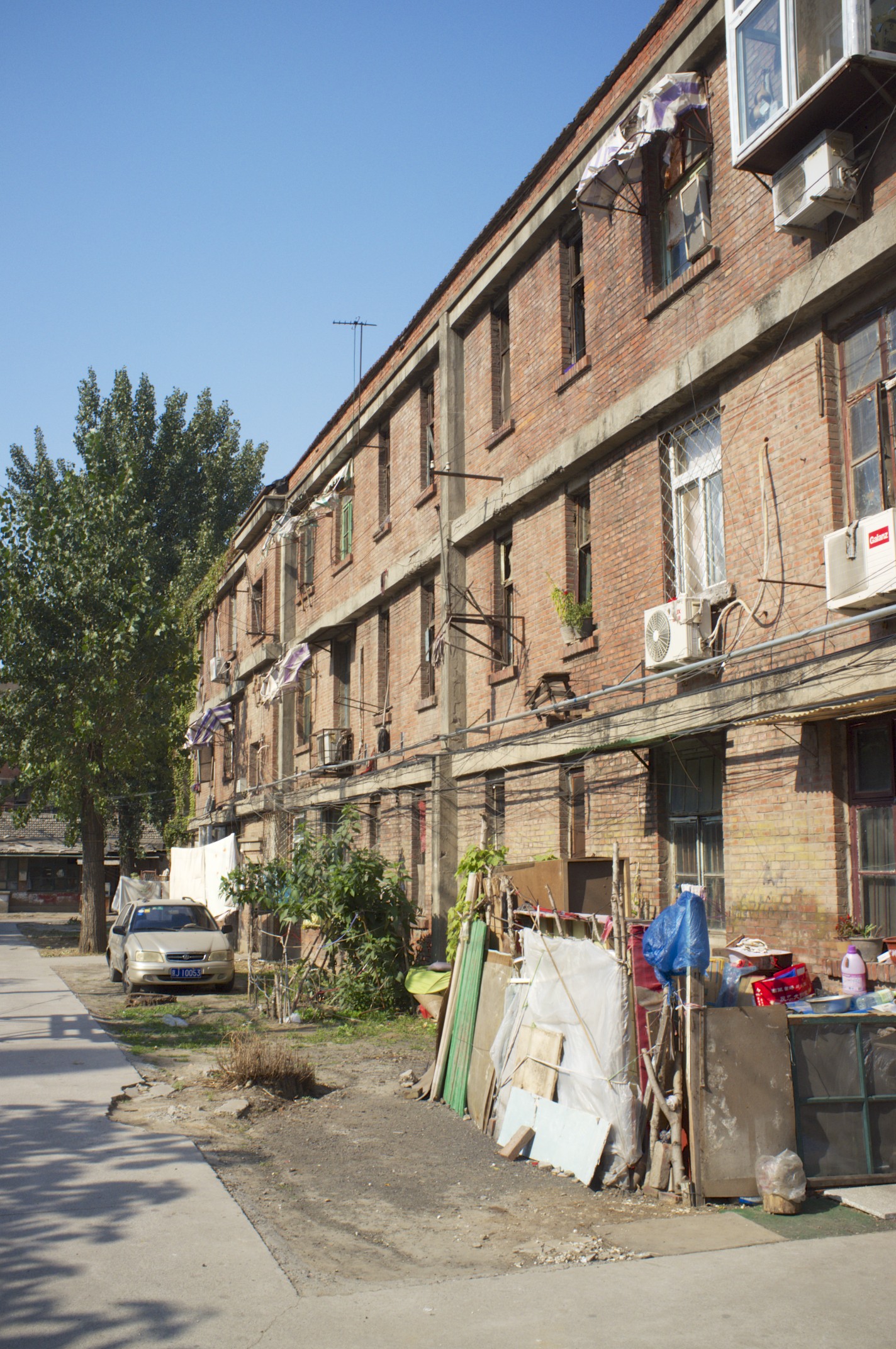
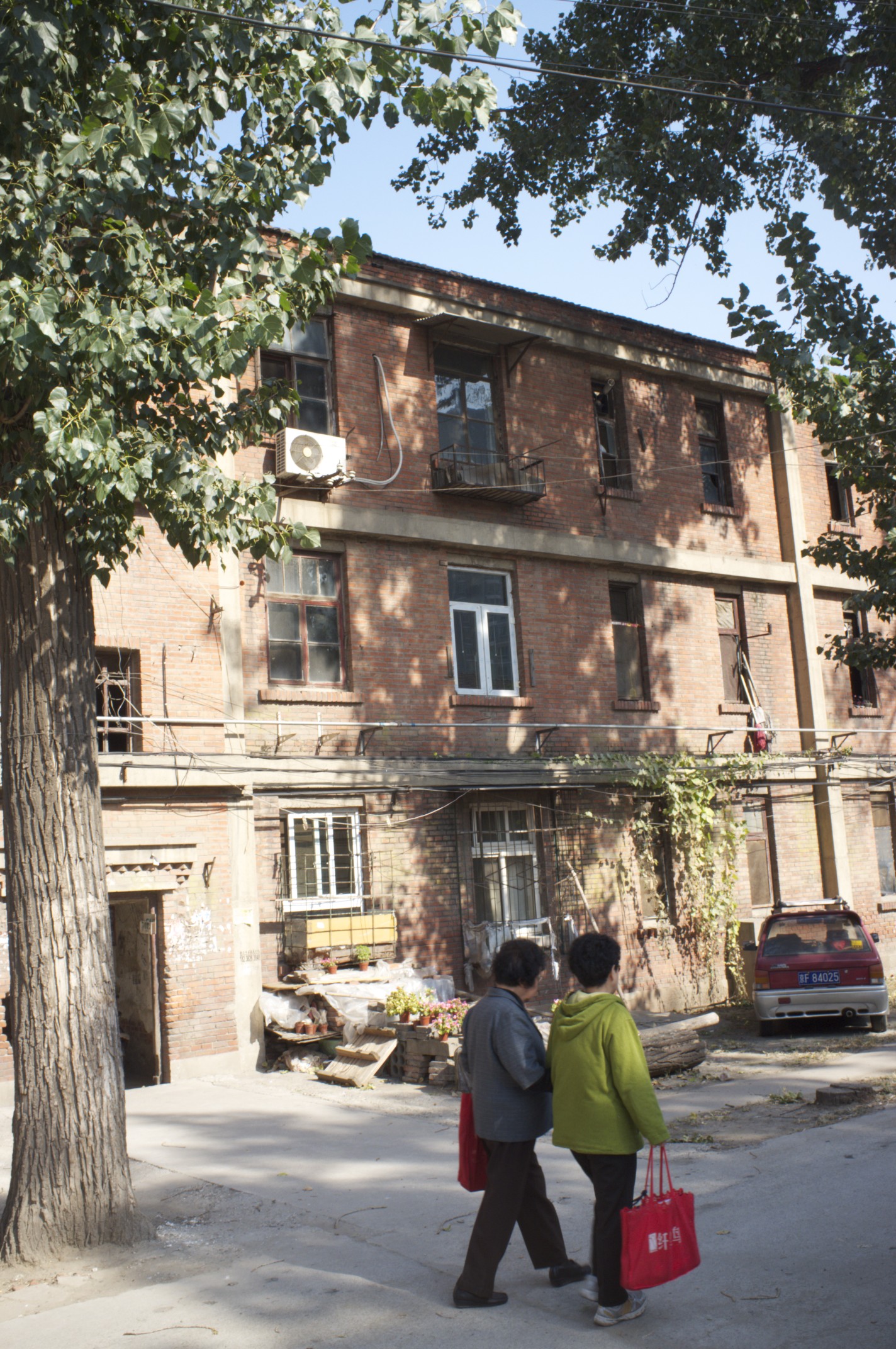
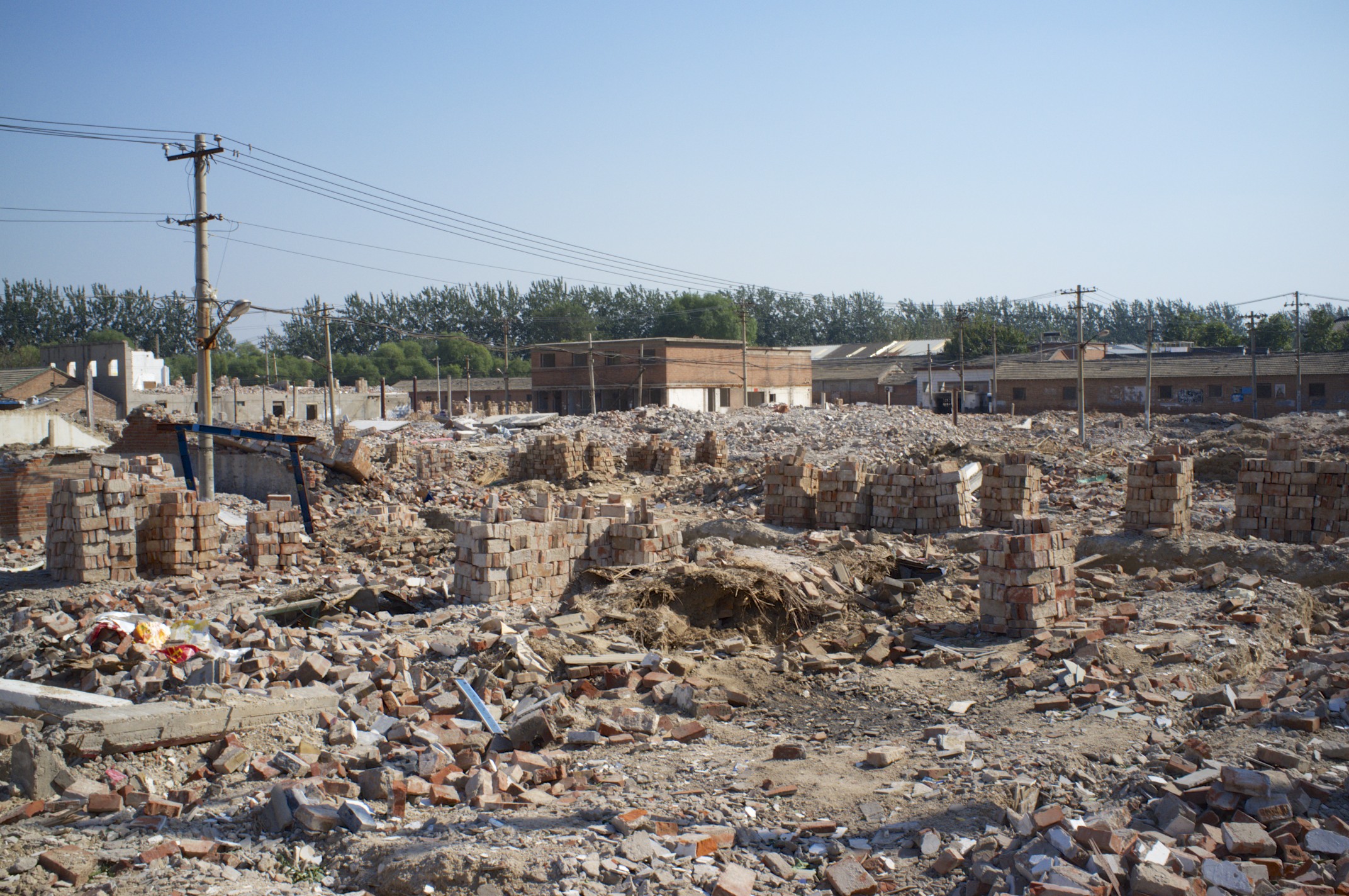
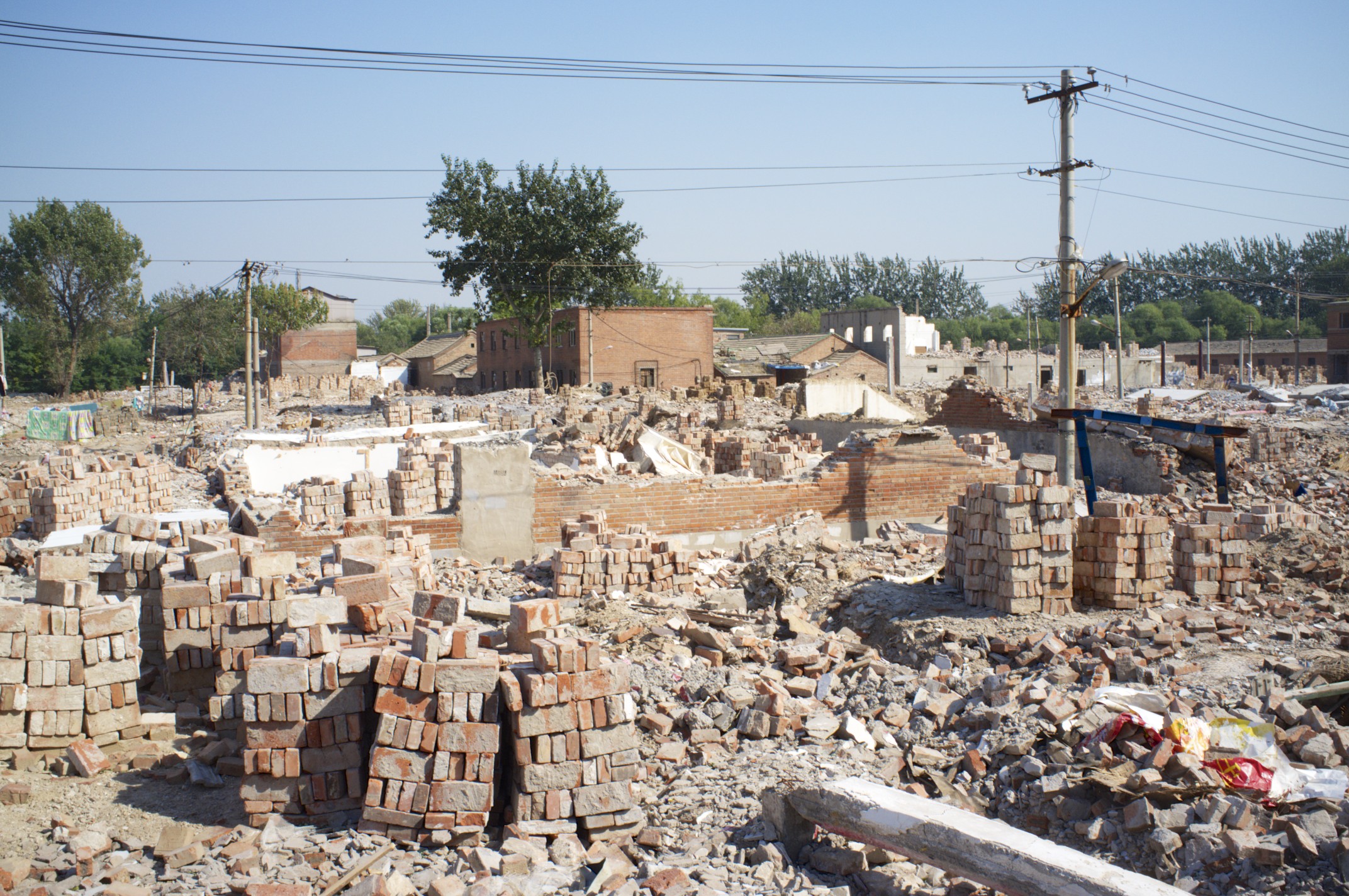
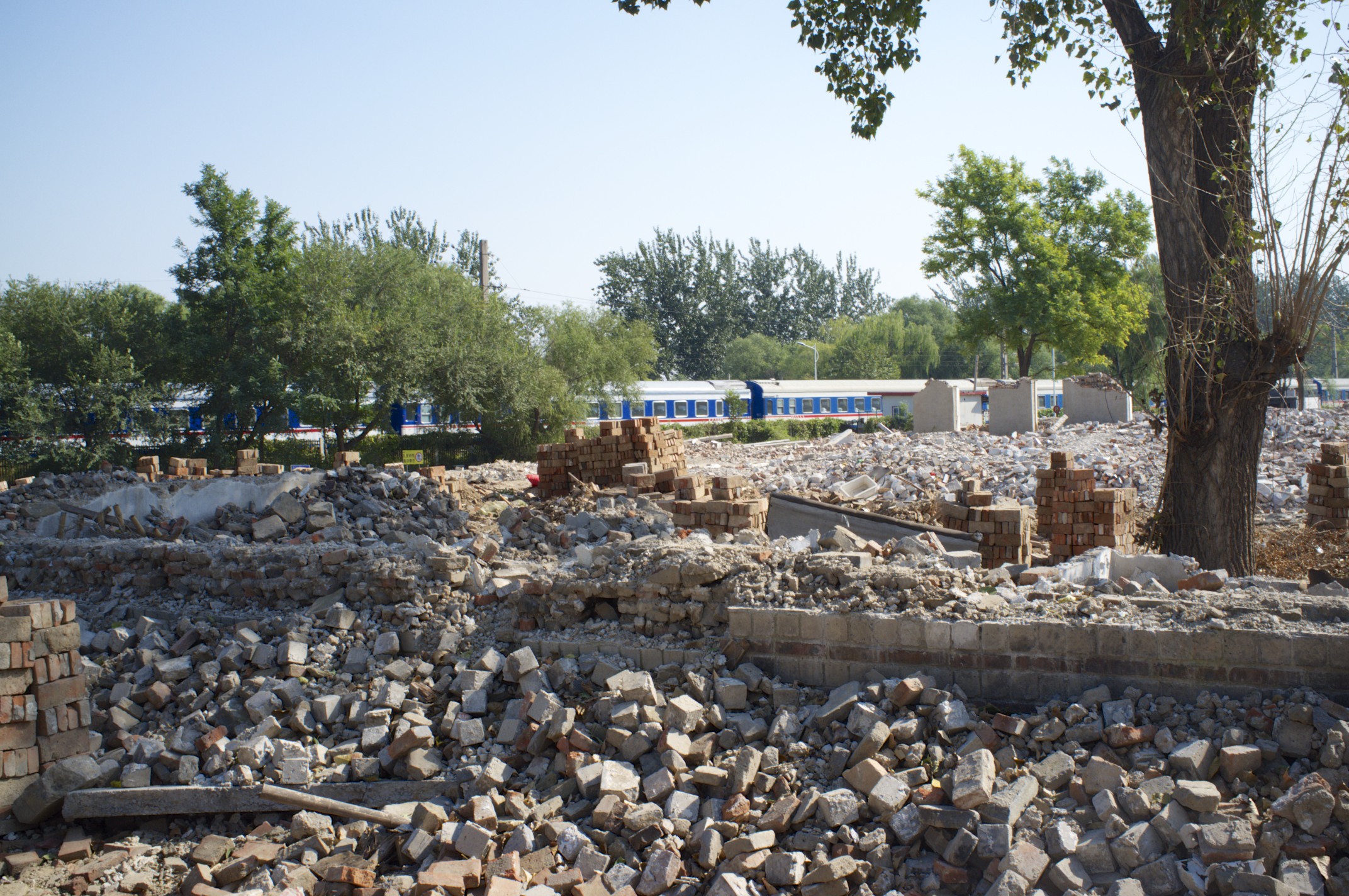
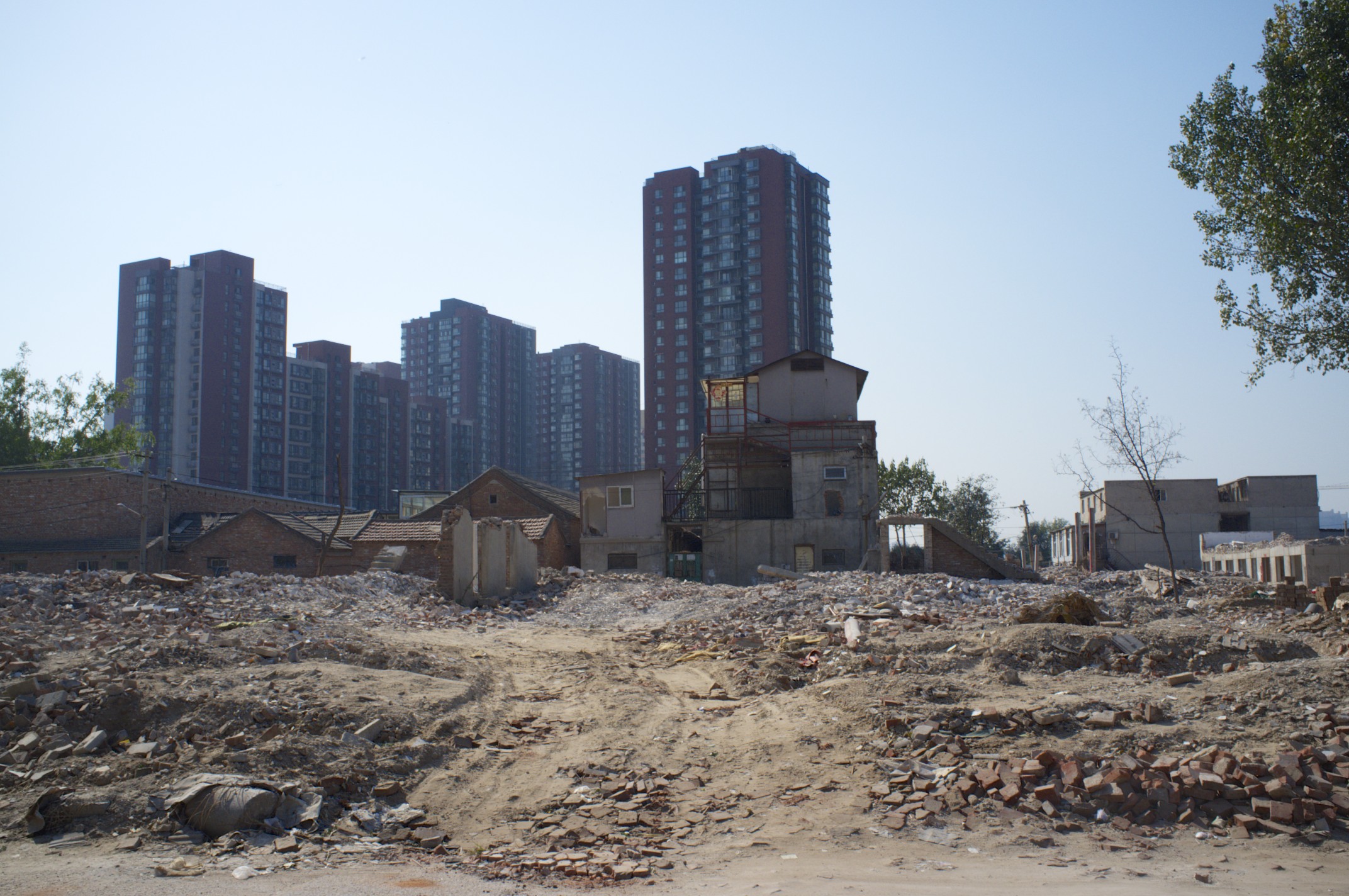
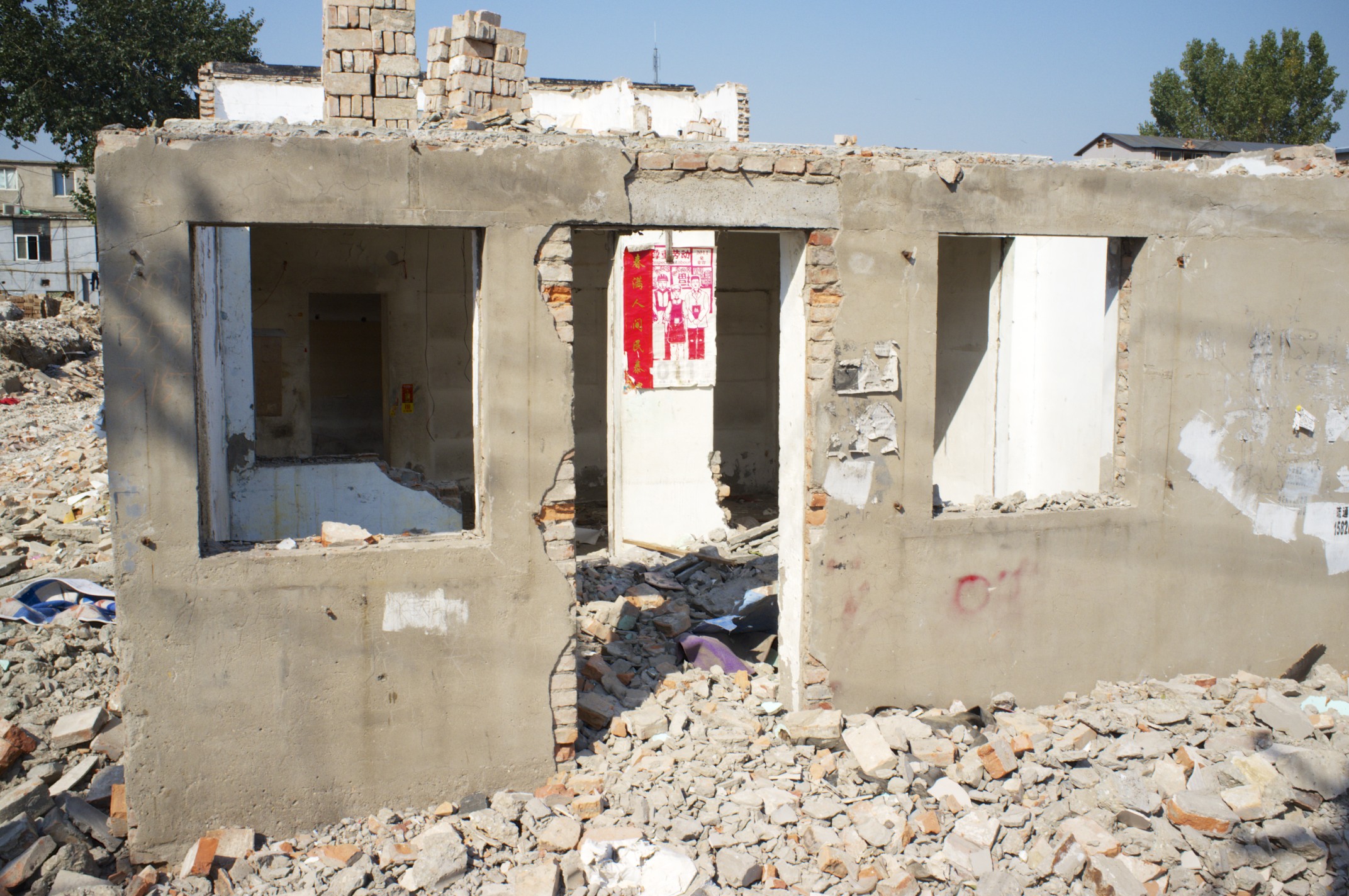

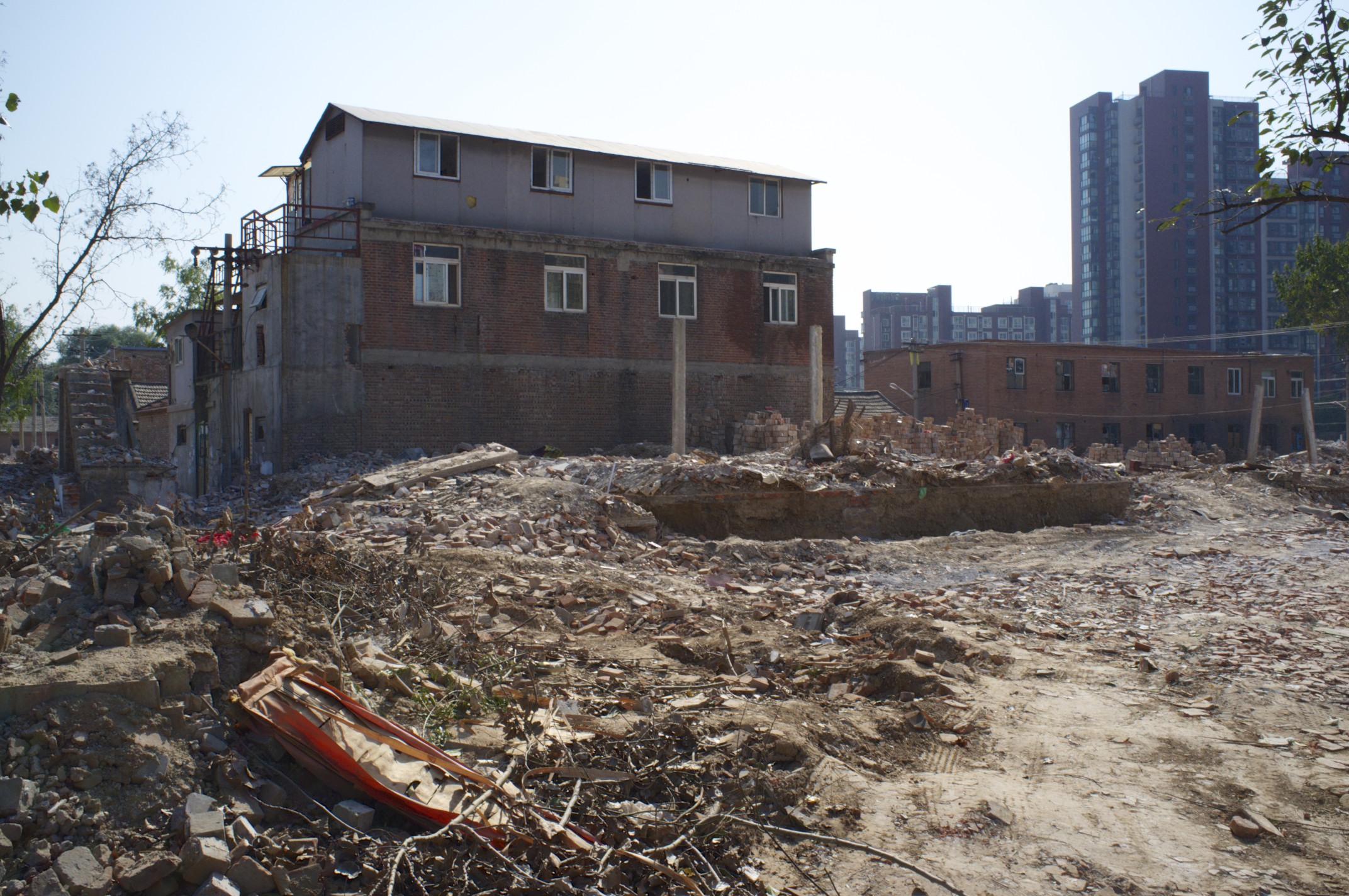
Location of the residential area which is still in tact.
- Satellite photo: Google Earth (on the 11th of October, 2013)
Location of a demolished area. In the East is the railway, which can be seen in one of the photos.
- Satellite photo: Google Earth (on the 11th of October, 2013)
Honey Walk
Unfortunately, I had to cancel this year's Easter egg hunt. I always thought that it would be a hide and seek game with the eggs. But now I learned that it is really called "egg hunt". Imagine the sound of horns in far, dogs running though the woods, horses, gunfire - and this time we are after eggs. Sounds a bit like Monty Phython to me. But anyway since I am in Beijing, the whole world sounds like Monty Phython. So why not that one also? Not sure, whether it is also a comedy, that North Korea declared yesterday to be in "state of war" with South Korea. Kim Jong Un, commonly known here as "Prince Fatty", is quite a clown though. Let's hope it is just another of his jokes, and we just don't get his humor.
Yesterday I had a nice walk with friends in the mountains West of the Great Nation's Capital. Still a bit overrun, because it is too easy to reach. But it was good to be above the smog for a while. Passed bye a honey farm. The peach trees are not blossoming yet, but was told that end of May the honey here is best. Not really organic. Amazing the bees don't die in the cocktail of smog and pesticides. Must be a special breed. Unrefined honey is said to be good for the immune system. These bees at least must have a "super immune system". So, this honey must be really good. I tried. It's sweet. And yes, it is unrefined. It really is.
If you like to go along the trails, you can download the GPS track by clicking here (in GPX-Format).
Going 33 km on one charge - no range anxiety
We constantly have discussions, which is the best way to move in Beijing. Quickly the topic comes to electric scooters or e-bikes, which are becoming more and more popular. And then comes the question, everybody answers differently: "How far can you go with one charge?"
Today, I did not talk about it. I did it. I went out to drain my bike to the last electron. It is a hybrid, which can be driven fully electric or as a supported bicycle - a so-called "Pedelec". The advantage to a scooter is, that you can extend range by pushing into the pedals and also, should the battery be really empty once, you can at least still get home. The manufacturer does not give information on the battery capacity or the power of the engine. Just the salesman said something like 25 km. So I expected this to be Chinese 25 km, which then should equal about, let's say 12 km.
I started with a full charge of the about 6 months old lithium ion battery and rode off into the haze through the Hutongs of Beijing, passing Tianamen Square and back to Dongzhimen.
Me, my clothes and water bottle made 90 kg payload. There was not much wind and temperature was around 20 Degree Celsius (that defines the battery capacity, which is lower at low temperatures). The route taken was quite flat and speed was sometimes limited by the traffic. As a result, the range was a surprising 33.2 km on electric drive. Then the engine suddenly fainted and I only had to make a few hundred meters on a conventional bicycle. Looking at the GPS track below (red line in the map), there is one outlier in the measurement which goes up to 120 km/h, which is of course an error. You can go quite continously at around 20 km/h and the average moving speed is with 13 km/h about what you can make with a car in Beijing. Quite good. Impressed.
Little journey to the West
One advantage of Beijing is, that you can easily get out. The Megcity has mountains in the North and West, which mark a sharp boundary between 1950s style coal power plants and a beautiful natural landscape. You might want to avoid tourist destinations, but still use public transport. And actually, this is quite well possible.
For example take the subway to Ping Guo Yuan (=Apple Garden, but don't be confused when you don't see any apple tree). It is the last stop of Line 1 in the West. Then walk 300 meters further West, until you see the bus stop for line 892. The bus service starts at 7:00 o'clock in the morning and runs very frequently. Stay on the bus for about 2 hours and get off at at the Fa Cheng bus stop, at N40 00.113 E115 47.949. This is a good starting point for a hike over the mountains and the decent to Jian Yuntai (N39 56.132 E115 51.110), for the bus 929 back to Ping Guo Yan station. The whole hike will take you around 7 hours. The last bus at Jian Juntai leaves at 17:40. If you miss that, you are (!) in trouble, as this is just a remote village which has no (!) other transportation.
The route gives a beautiful outlook over the mountains. There are nearly no people up there. The villagers do not grow nuts or fruits like in other rural regions around Beijing. Still the terraces along the slopes witness an agricultural past here. The trails are just kept open by a few hikers per year and you need a thorn proof jacket. Strictly stay on the trails, which are occasionally steep and going along fringes. Hikers here use 435.000 MHz and 437.900 MHz.
For your GPS you may download the trail by clicking here in gpx-format.
Vive le "Velosolex"

But on my Odyssey, I had a closer look at the electric bicycles available. There is a whole range of electric scooters, but my interest was in some kind of "muscle-electric hybrid", which also is called "Pedelec". I have been trying a prototype from a colleague once, and found this the "Velosolex of the 21st Century". Not many remember the old bicycle with the small one cylinder two stroke support engine which was just flipped on the front tire when needed. I was still once riding one in the late 70s, and remember well how it blew the oily exhaust fumes strait into my face. Of course this does not happen with an electric version. Actually, the original version of the Velosolex is still available and is advertised in the US, as the "French way of getting from A to B". Other electric personal mobility concepts are provided for example by Segway. Segways are also available in China, via an importer in Guandong Province, but far too expensive to compete with the local bicycle electric competition. The one I decided for, is a simple 20 inch bicycle with a 36 Volt (10 AH) Lithium Ion battery, which is supporting via a 240 Watt motor in the front wheel. Really a bit like a Velosolex. But the manfacturer is Giant, which is a Taiwanese company, of which lso my racing bike is made. Could be called the "Chinese way of getting from A to B". The range is very much determined on how much you rely on the engine and how much you paddle. It is really a hybrid. Today I tried out nearly the full electrical range, which is about 20 km. Then the engine stopped abruptly and went home on a conventional push bike.































